
American Arborvitae
Arbor Walk #62, Treekeeper ID #4666
The American Arborvitae is most prevalent in eastern and central Canada, and found in Northern Illinois, Ohio, and New York as well as scattered populations further south. St. Louis is near the southern end of the tree’s range, and it benefits from being in a slightly shadier location than they would prefer in their northern ranges.
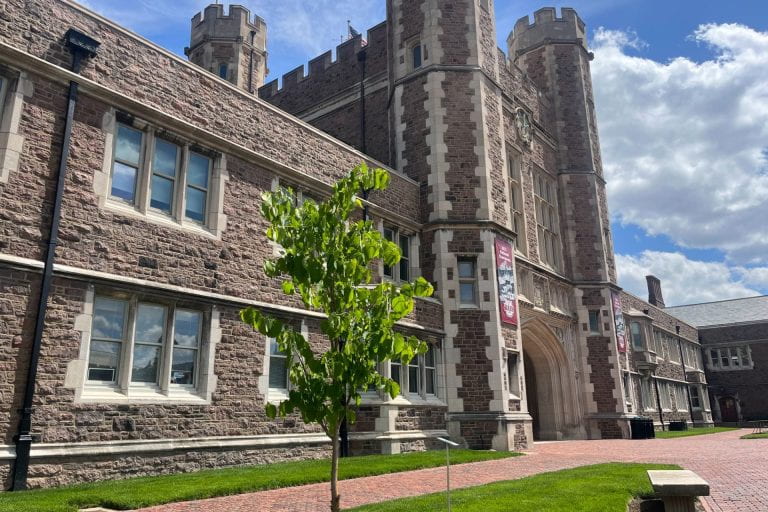
American Basswood
Arbor Walk #153, Treekeeper ID #8101
This tree is a grafted clone of the original Basswood which has been growing in Brookings Quad for more than 100 years.
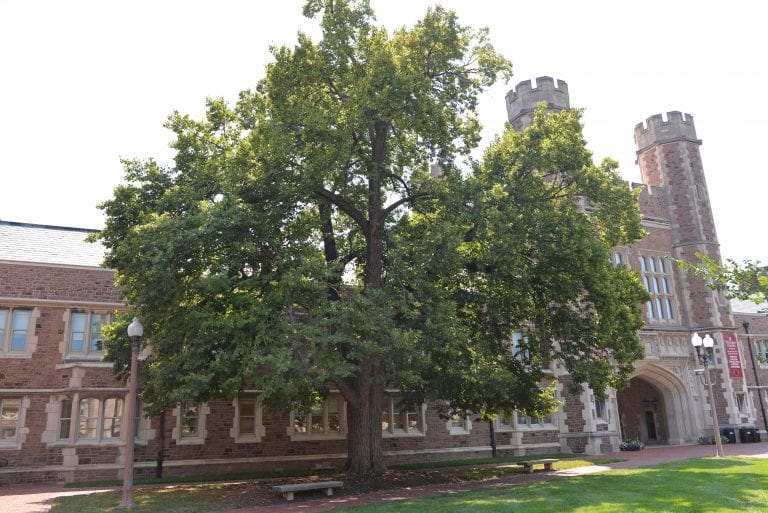
American Basswood (removed July 2023)
Arbor Walk #17, Treekeeper ID #1937
This is one of the oldest and largest trees on campus. It has large green leaves and small, sweetly scented flowers. Recently, efforts have been taken to preserve and continue on the genetic lineage of this tree whose history follows that of WashU’s Danforth Campus.
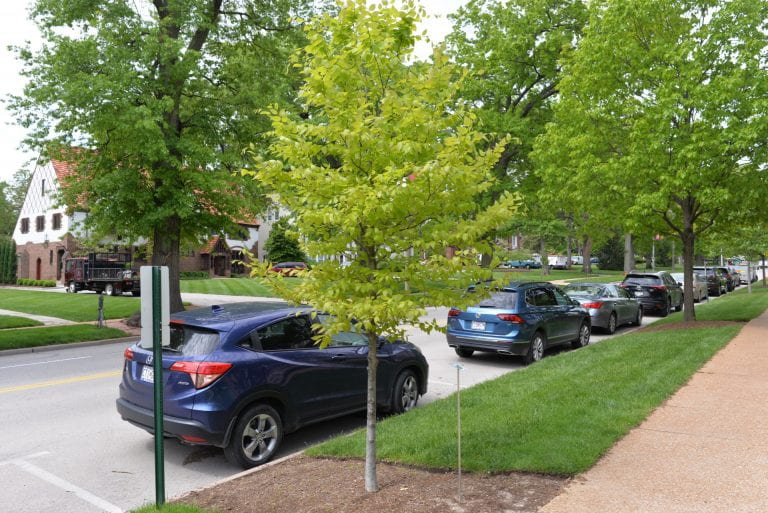
American Beech
Arbor Walk #48, Treekeeper ID #1979
This tree has dark green leaves which turn bronze in the fall. Its flowers are yellowish-green, and the female flowers yield edible beechnuts which ripen in the fall.

American Chestnut
Arbor Walk #111, Treekeeper ID #6353
The American Chestnut is a historically and cuturally important tree that unfortunately has a sad story. This species used to be one of the biggest and most numerous trees in the Eastern United States, but it is now functionally extinct.
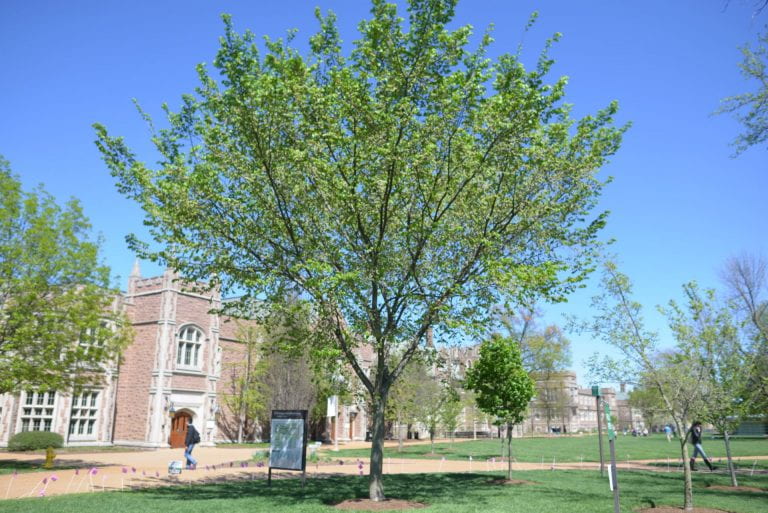
American Elm
Arbor Walk #31, Treekeeper ID #2408
The American Elm is native to much of Eastern North America and grows in low, moist areas and along streams across the state of Missouri.
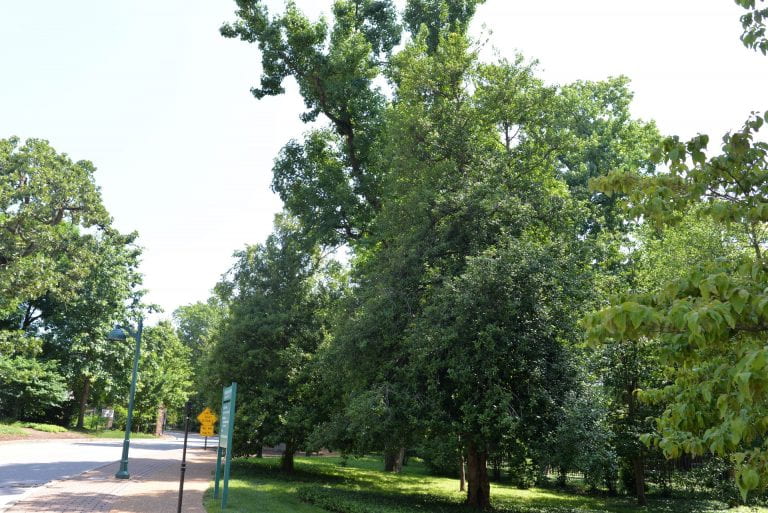
American Holly
Arbor Walk #69, Treekeeper ID #3034
The American Holly is a broad-leaved evergreen tree reaching 40 to 50 feet high, densely pyramidal in youth becoming more open and symmetrically conical with age.
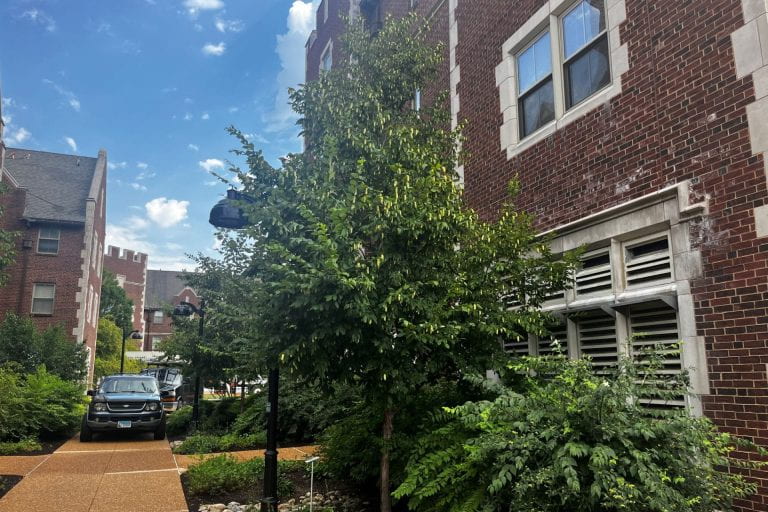
American Hop Hornbeam
Arbor Walk #112, TreeKeeper ID #3680
Native to much of the continental U.S., the American Hop Hornbeam is a great tree. It has orangish-brown, loose bark and catkins that stay on over winter making it an interesting and beautiful tree year-round.
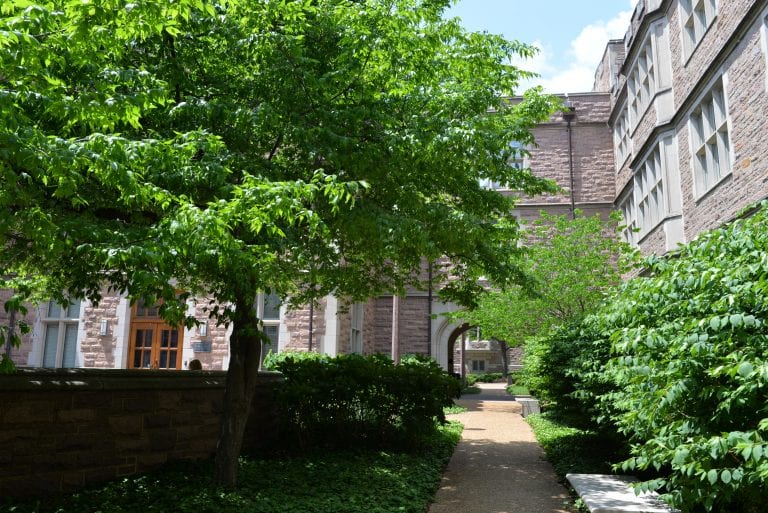
American Hornbeam
Arbor Walk #20, Treekeeper ID #1933
Native to the midwest, the American Hornbeam typically grows as an understory tree, in wetter areas. Its leaf is dark green, ovate, with doubly serrated edges.
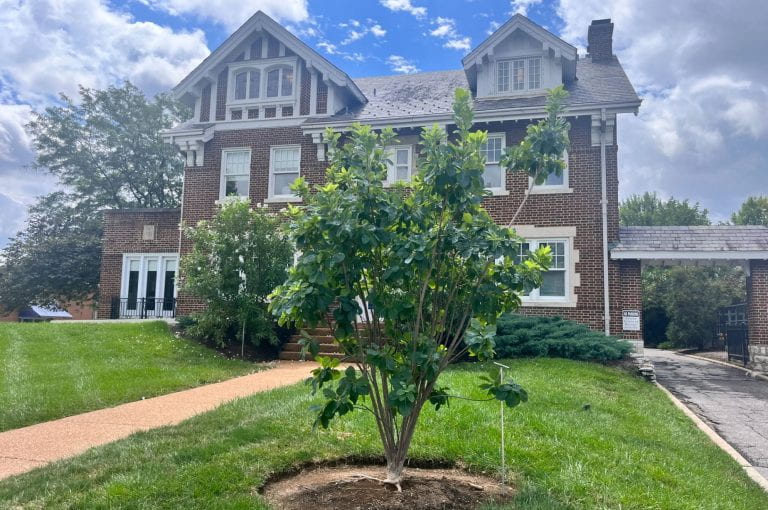
American Smoketree
Arbor Walk #166, Treekeeper ID #6601
The American Smoketree is a Missouri native tree with fabulous color in the spring and summer, thanks to its smoke-like purple-haired inflorescences.
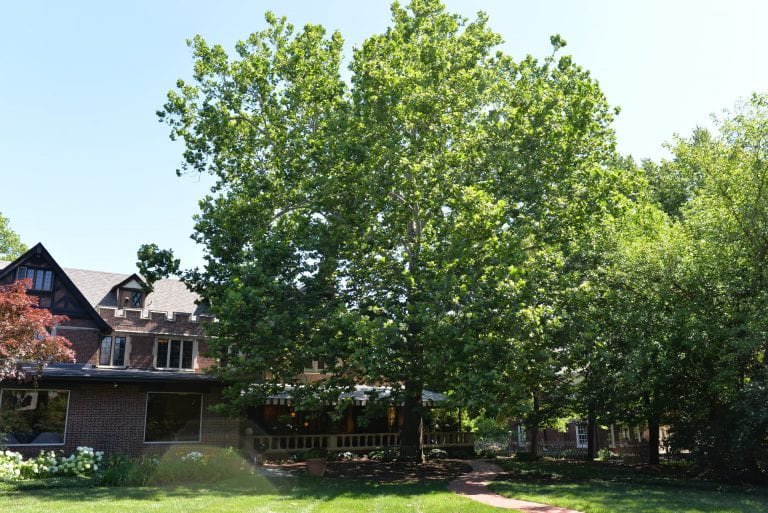
American Sycamore
Arbor Walk #60, Treekeeper ID #5449
The Sycamore is regarded as one of the largest trees native to eastern North America, and was historically prized by Native Americans for the construction of dugout canoes. Ecologically, they are early colonizers to newly available habitat, and support animal shelters as they mature.
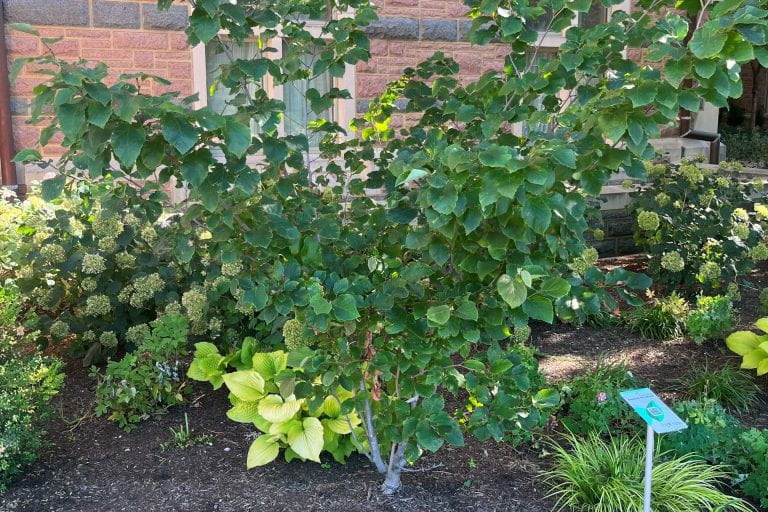
American Witchhazel
Arbor Walk #119, TreeKeeper ID #6211
The American Witchhazel is one of the few deciduous woody plants that flowers after the leaves fall. It typically flowers during October to December.
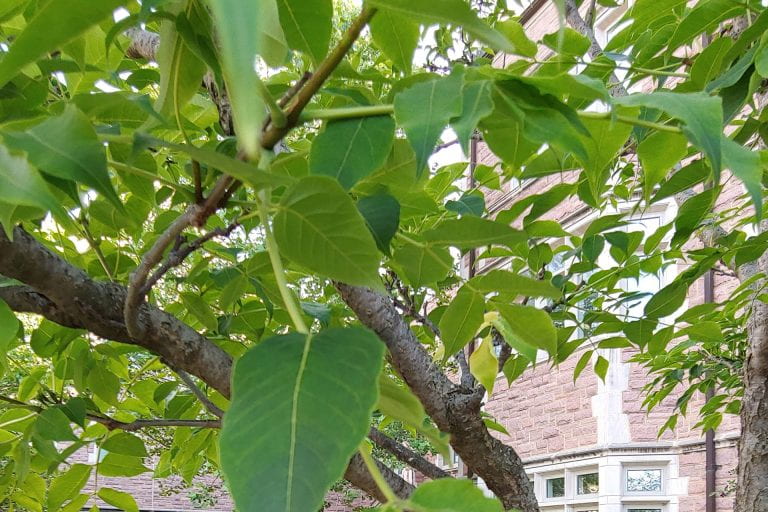
Amur Cork Tree
Arbor Walk #101, Treekeeper ID #1905
The Amur Cork Tree is native to China and Japan. The species is able to tolerate some drought conditions and urban pollutants. They are known for attractive, furrowed bark that resembles cork, as is apparent within its name.

Arizona Sycamore
Arbor Walk #171, Treekeeper ID #7177
The Arizona Sycamore is one of three native sycamore species in North America, and is the species with the most limited range.
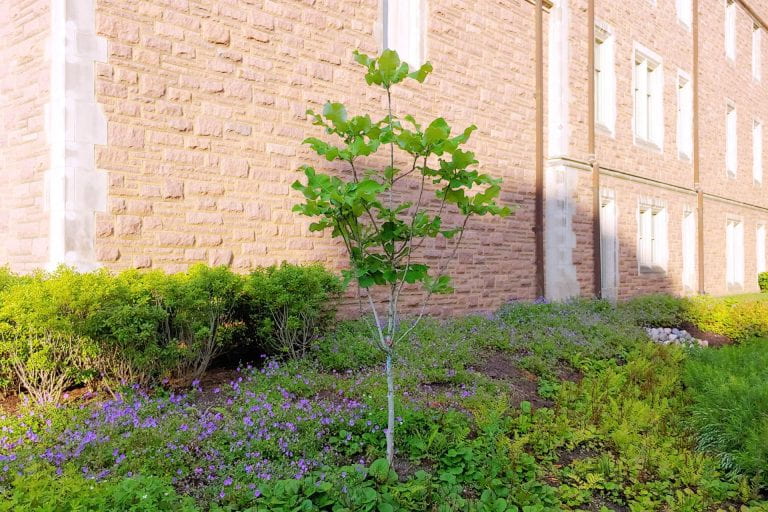
Ashe’s Magnolia
Arbor Walk #92, Treekeeper ID #4775
The Ashe’s Magnolia is a regional native to the Southeastern US and adaptable to the St. Louis Region, typically growing to 10’ to 20’ tall and 10’ to 15’ wide.
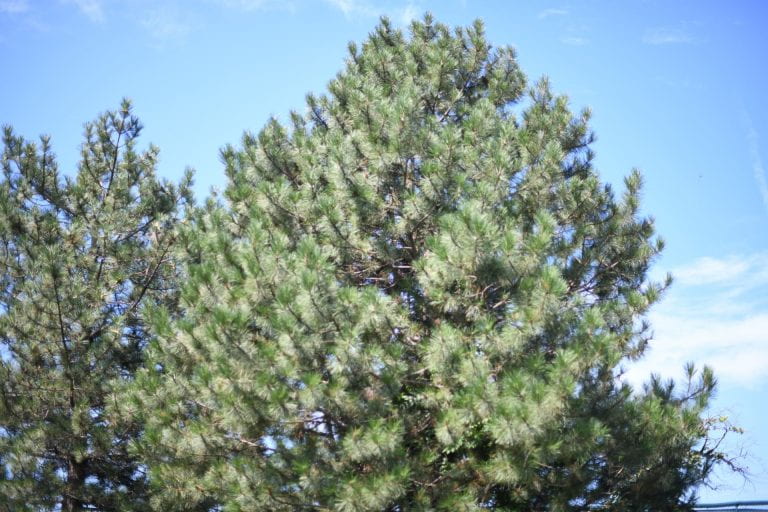
Austrian Pine
Arbor Walk #83, Treekeeper ID #3668
This is a medium to large conifer than is native to Europe and Asia. They are dense and pyramidal when young and round with age. These trees feature spreading branches, stiff, dark green needles in bundles, and oval cones.
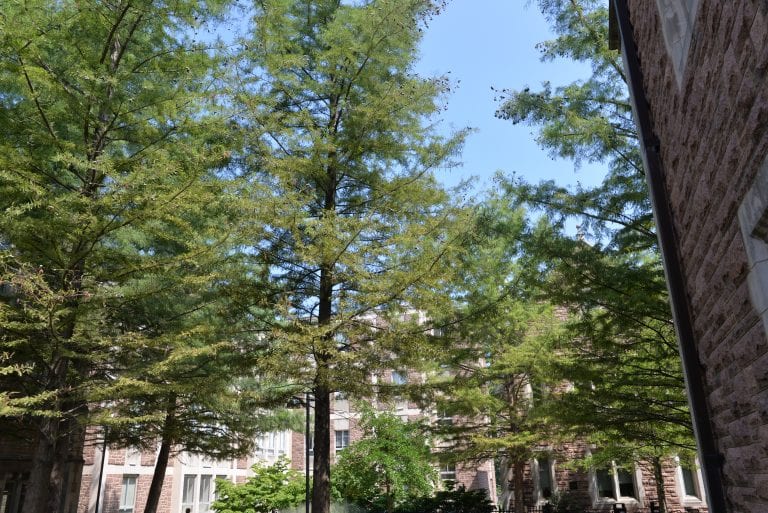
Bald Cypress
Arbor Walk #16, Treekeeper ID #1427
This tree is native to wetlands and swamps in the Midwest but is adaptable to urban conditions. Its needlelike foliage turns russet red and drops in the fall.
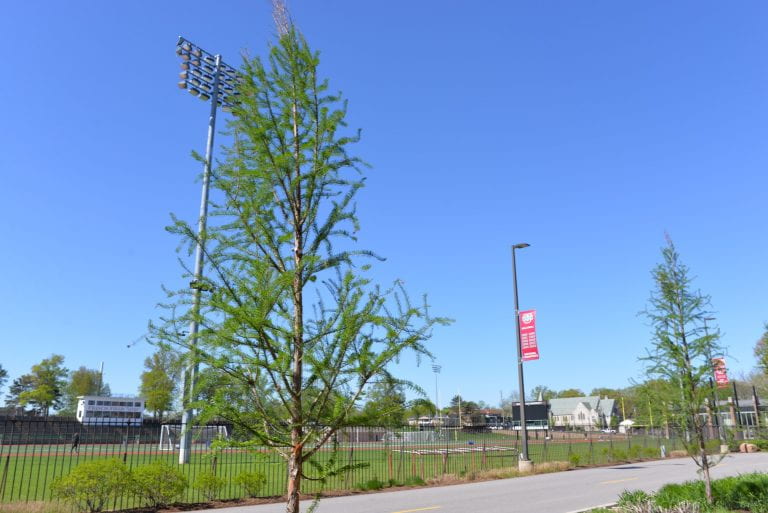
Bald Cypress
Arbor Walk #37, Treekeeper ID #2507
The Bald Cypress is the state tree of Louisiana. Despite its resemblance to a needled evergreen tree in the summer, it is actually deciduous. The ‘Mickelson’ is a cultivar of the Bald Cypress, and has a narrower shape and denser foliage than the native species.

Beach Plum
Arbor Walk #143, Treekeeper ID #6824
This fruit tree derives its name from its restricted habitat in sandy areas like beaches, dunes, and tidal streams.

Bebb’s Hybrid Oak
Arbor Walk #145, Treekeeper ID #6550
This oak is a spontaneously occurring hybrid of the White Oak (Quercus alba) and the Bur Oak (Q. macrocarpa).

Bigtooth Aspen
Arbor Walk #155, Treekeeper ID #8051
This aspen is found in the northeastern United States and southeastern Canada, and has distinctly egg-shaped leaves with blunt, narrow teeth and flattened petioles.
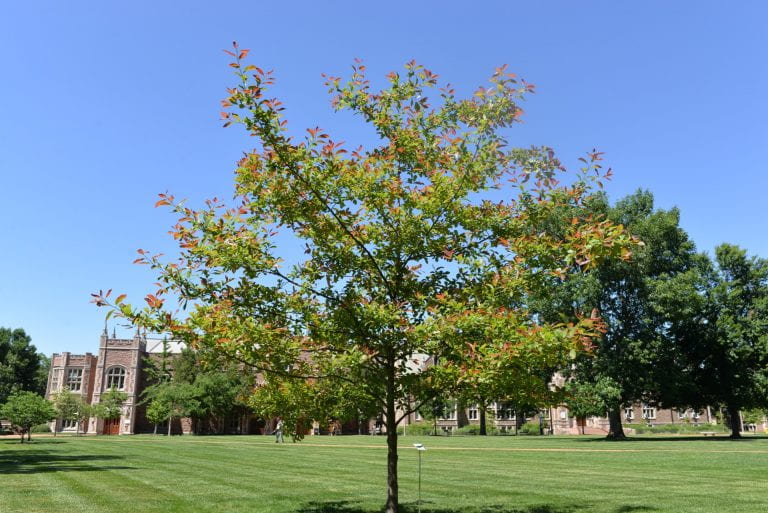
Black Gum
Arbor Walk #32, Treekeeper ID #2247
The Black Gum, also called Tupelo, is a Missouri native and flexible mid-western species capable of growing in both standing water and rocky slopes.
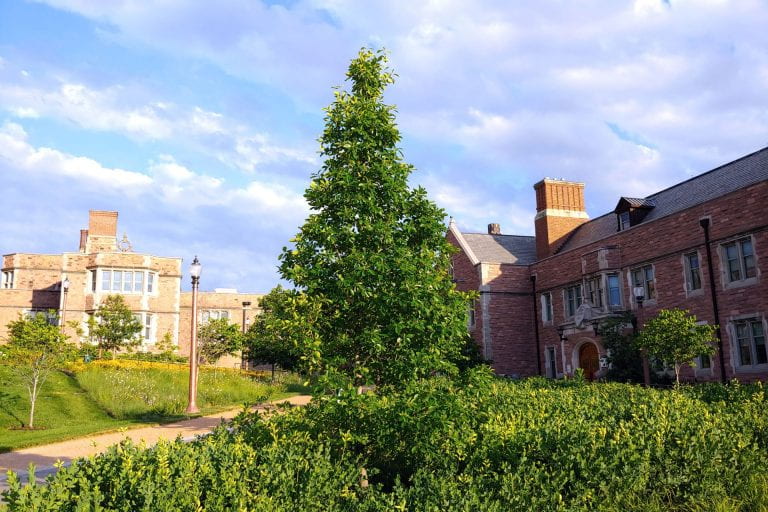
Black Gum
Arbor Walk #91, Treekeeper ID #5922
The Black Gum, also known regionally as Black Tupelo, is a part of the Nyssaceae family, which used to be under the dogwood family.

Black Maple
Arbor Walk #173, Treekeeper ID #6384
Alternatively described as a closely related species of Sugar Maple (Acer saccharum) or as its subspecies, the Black Maple overlaps in range with the Sugar Maple but shifted farther west into the Midwestern Plains.
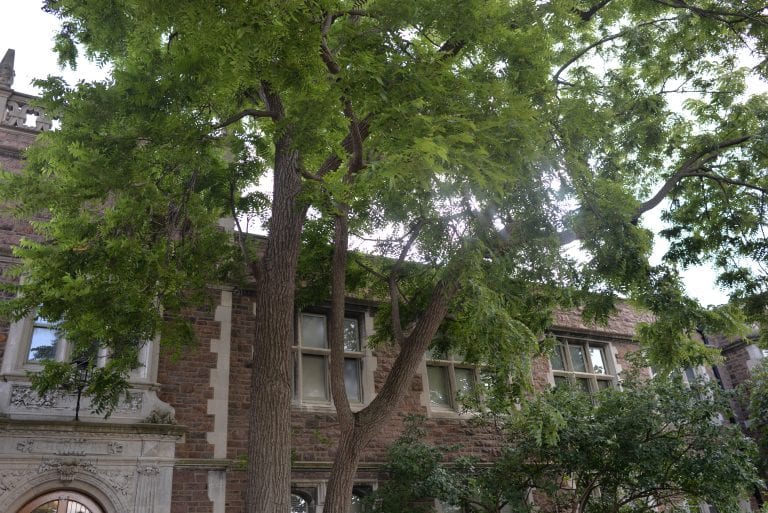
Black Walnut
Arbor Walk #18, Treekeeper ID #1386
This is a large native tree whose wood is used for woodworking in the furniture and cabinet industry.
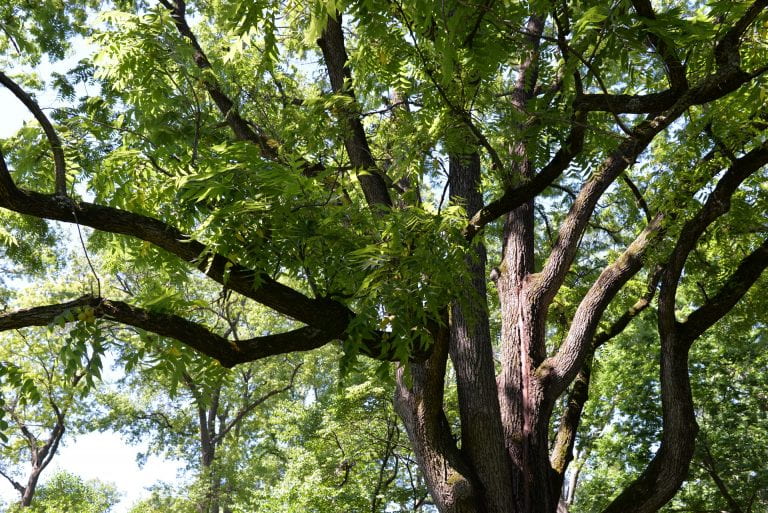
Black Walnut (Deaccessioned)
Arbor Walk #61, Treekeeper ID #5016
This is a large deciduous tree common to woodlands in the eastern United States from Massachusetts to Texas. It is natively found in rich woods and fertile river valleys across the state of Missouri.
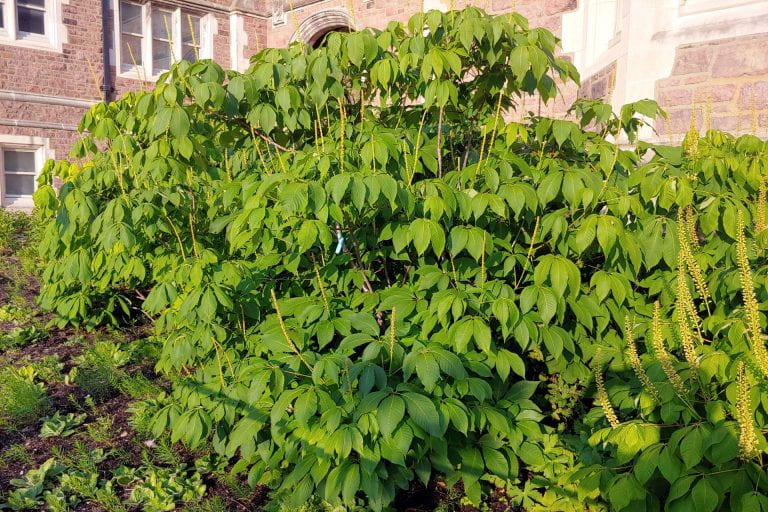
Bottlebrush Buckeye
Arbor Walk #89, TreeKeeper ID #8345
Bottlebrush Buckeye is not native to Missouri but is very adaptable to the St. Louis Region. It is a multiple stem understory small tree or large shrub which colonizes by suckering.
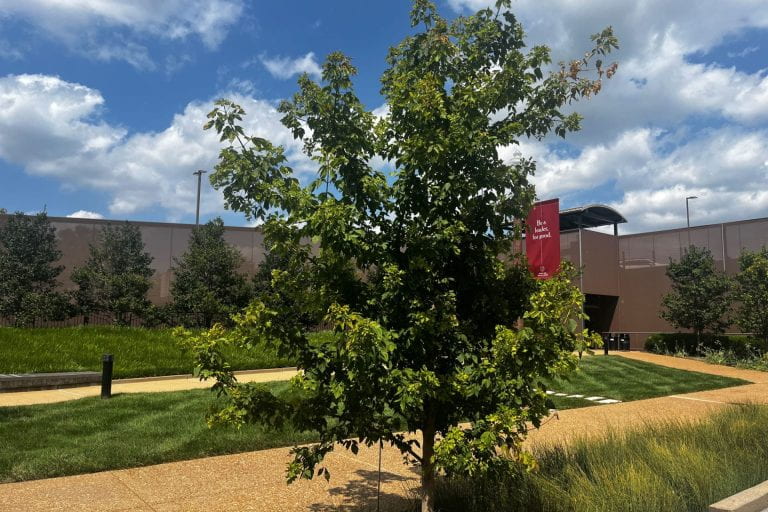
Boxelder Maple
Arbor Walk #118, TreeKeeper ID #6843
Boxelder Maple is notable because of the usual leaves this species has compared to all other native maples. Instead of the normal simple leaf, it instead has compound leaves, which means it has leaflets.
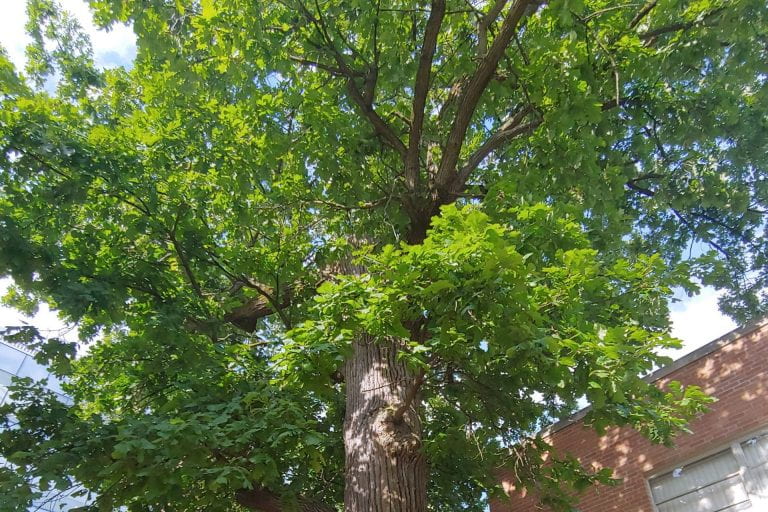
Bur Oak
Arbor Walk #108, Treekeeper ID #1757
This tree is in the Fagaceae family and is native to Missouri. It is a deciduous tree with broad and rounded crown, which is good for shading. The leaves are leathery, dark green and turn to yellow-brown in fall. The oval acorns are large in size with fringed cups.

Butternut
Arbor Walk #161, TreeKeeper ID #6339
Although this tree has a broad range within the Upper Midwest and Northeast United States, it is uncommon in most of its range, being overshadowed by its ubiquitous relative Juglans nigra, the black walnut. Its lack of prominence is mainly caused by the deadly butternut canker, which only affects J. cinerea.
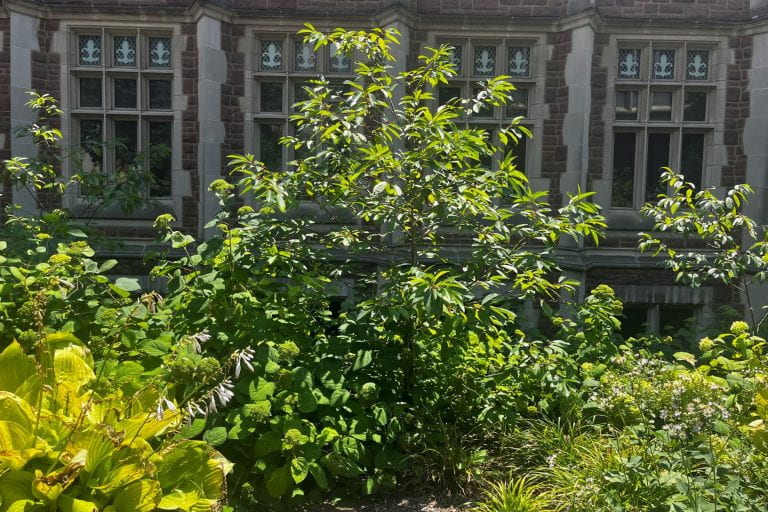
Carolina Buckthorn
Arbor Walk #130, TreeKeeper ID #5899
Even though it is called a buckthorn, Carolina Buckthorn has no spines. The shrub is well known for its bright red drupes during the summer. The fruit eventually mature to black and attracts many wildlife species, especially birds.
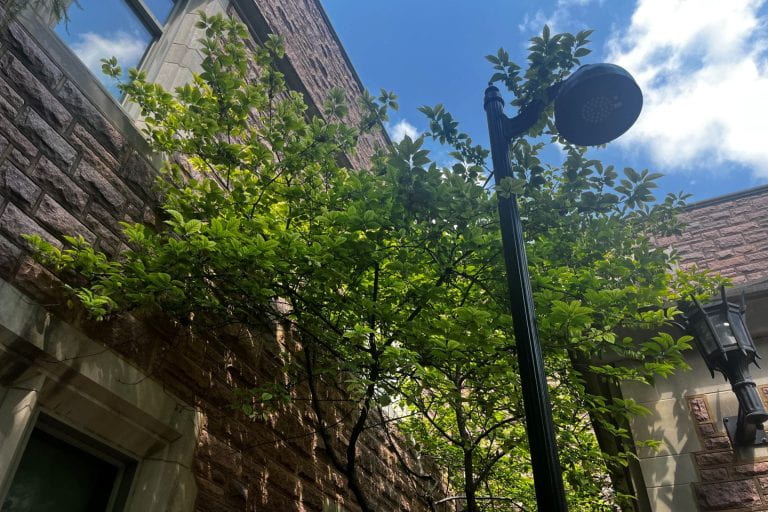
Carolina Silverbell
Arbor Walk #132, TreeKeeper ID #1468
The best place to find this plant in the wild is the Great Smokey Mountains where they thrive. Squirrels love the four-winged, dry fruit, and Tennessee beekeepers describe it as a great honey tree. The wood is also sometimes used for cabinets, veneer, and carvings.
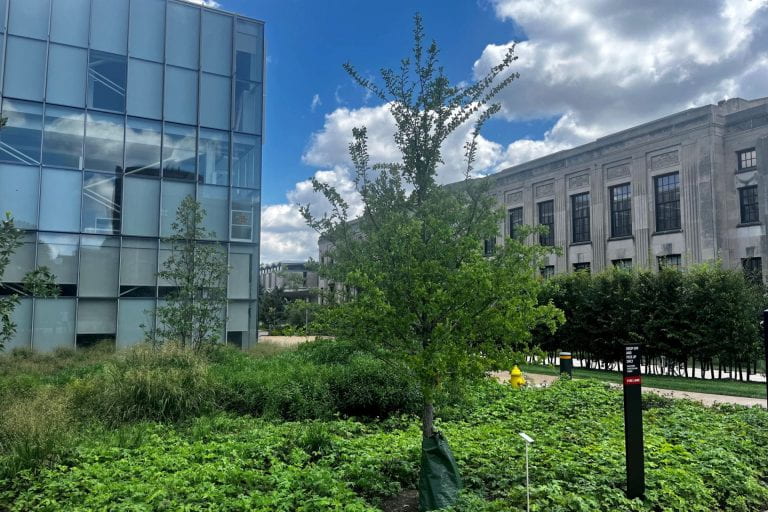
Cedar Elm
Arbor Walk #163, TreeKeeper ID #5618
The Cedar Elm is a drought-tolerant, medium-sized elm native to Texas and the Lower Mississippi River region.
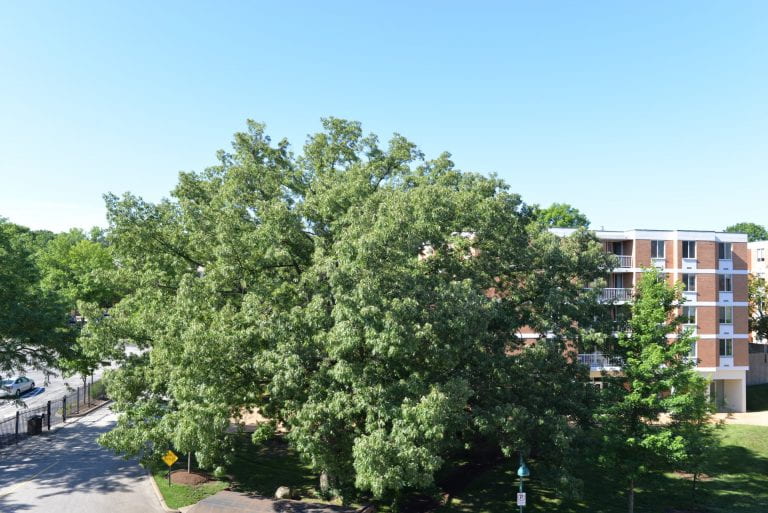
Cherrybark Oak
Arbor Walk #71, TreeKeeper ID #3472
Cherrybark Oak is a medium to large-sized deciduous tree native to the Southern US including the southeast corner of Missouri. The Cherrybark Oak looks very similar to another Missouri native, Southern Red Oak. So much so, that this tree was mislabeled as a Southern Red Oak for many years in the Arboretum.

Chestnut Oak
Arbor Walk #152, Treekeeper ID #6051
The Chestnut Oak has a native range just bordering but not within Missouri; it thrives in dry uplands from southern Maine to the Mississippi but primarily in the Appalachian Mountains.

Chinese Fringetree
Arbor Walk #160, TreeKeeper ID #6268
The Chinese Fringetree is a small tree with distinctive long white-petalled flowers and olive-like fruit, very similar to our native Fringetree.

Chinese Redbud
Arbor Walk #148, TreeKeeper ID #6270
The Chinese Redbud is within the same genus as the Eastern Redbud, but features larger, bright magenta flowers and glossy heart-shaped leaves.
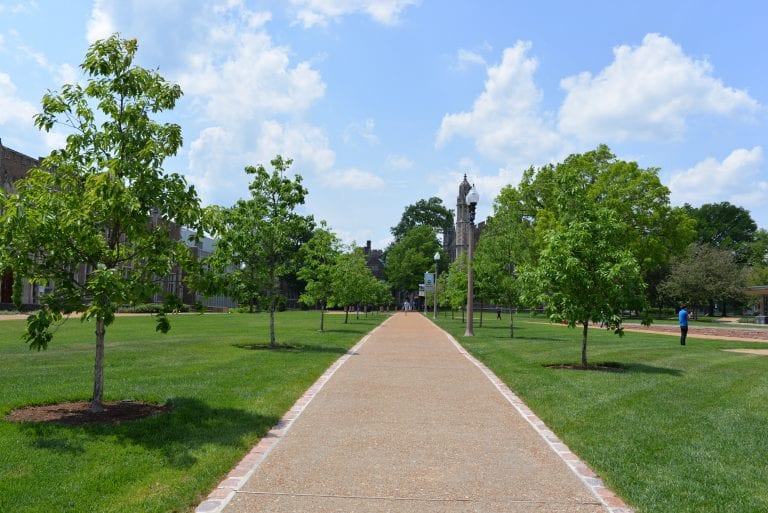
Chinkapin Oak
Arbor Walk #26, Treekeeper ID #1345
Native to the Midwest, the Chinkapin Oak can be easily recognized due to its small, toothed leaves. Unlike most oaks, the Chinkapin has unusually flaky and fissured bark.

Chitalpa
Arbor Walk #164, TreeKeeper ID #8241
The Chitalpa is an inter-generic hybrid of two species (Chilopsis linearis and Catalpa bignonoides) from the Bignoniaceae family.
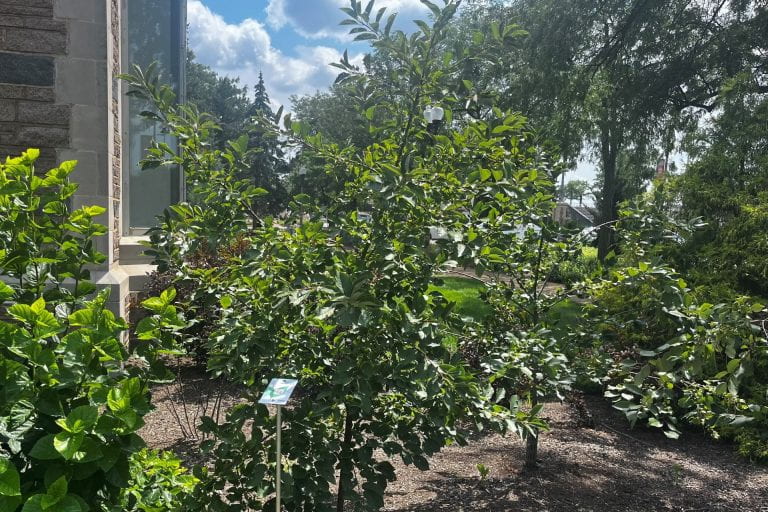
Chokecherry
Arbor Walk #123, TreeKeeper ID #7105
The wild Chokecherry is usually found in dense thickets due to its vast root system which can sprout runners, but on campus you will find them managed to prevent this. It blooms beautiful white flowers that eventually turn into dark purple fruit.
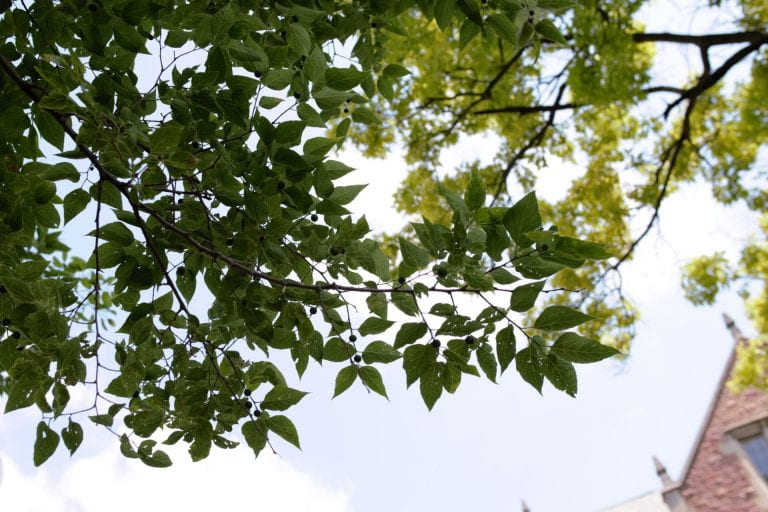
Common Hackberry
Arbor Walk #8, Treekeeper ID #6122
This native tree performs well in urban conditions and is easily identified by its distinctive corky bark. But be careful because there are other relatives that are native to Missouri that have very similar bark.
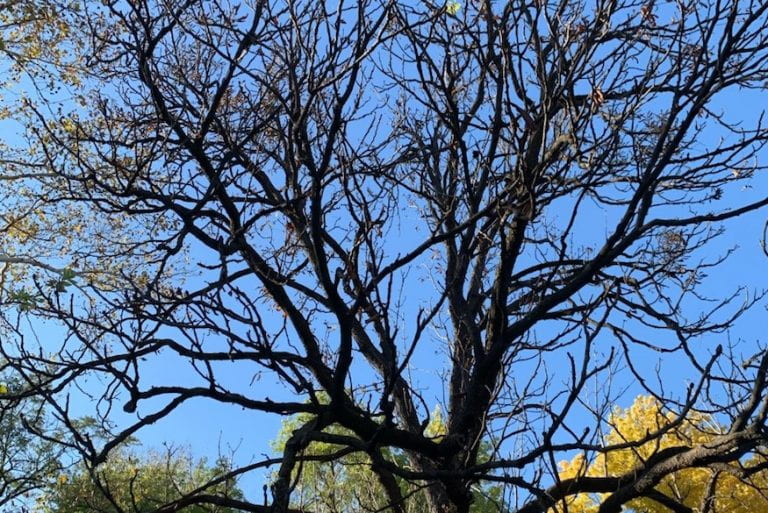
Common Horse Chestnut
Arbor Walk #64, Treekeeper ID #5490
Despite being widely planted as an easy-to-grow shade tree for streets and landscapes throughout the Midwest, the Common Horse Chestnut is originally native to the Balkan region of Europe. The tree features showy white flowers in spring which in summer transition into fruit, consisting of one or two seeds encased in a spiny husk.
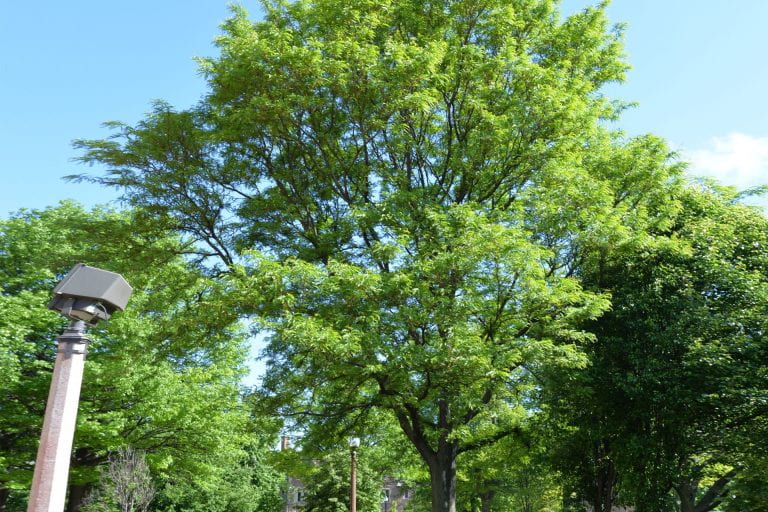
Common Thornless Honeylocust
Arbor Walk #28, Treekeeper ID #1610
This is a native plant, but if found in nature, its bark would likely be covered in long, sharp thorns. Arborists tend to plant this natural, thornless variant of the tree to allow people to see its beauty without obtaining injuries.
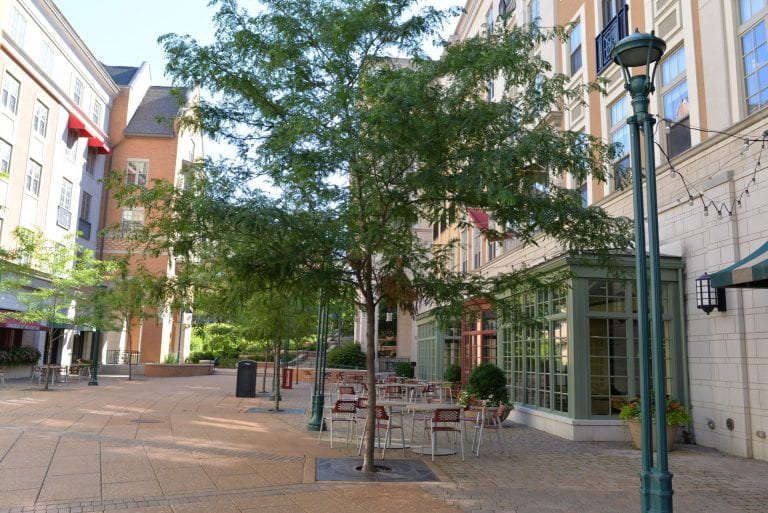
Common Thornless Honeylocust
Arbor Walk #78, Treekeeper ID #3229
The Honeylocust is a tough, medium-sized shade tree that usually grows around 60′ to 80′ tall. It has greenish-yellow to greenish-white flowers that appear in May or June.
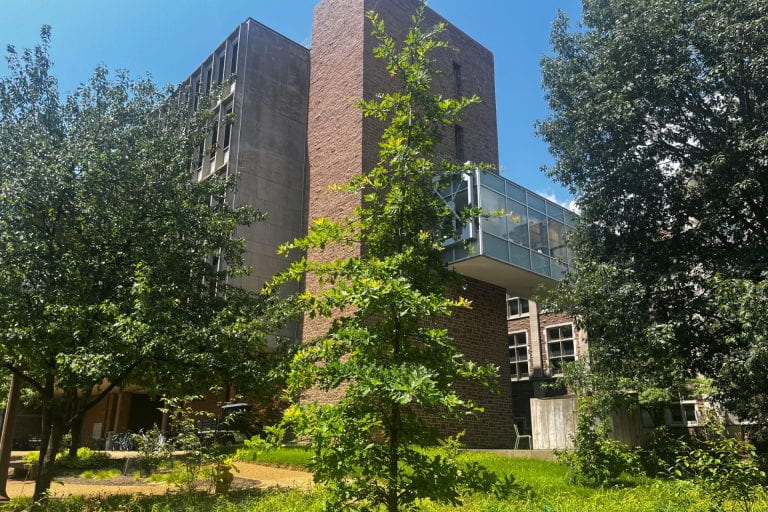
Compton Hybrid Oak
Arbor Walk #128, TreeKeeper ID #1645
The Compton Hybrid Oak is a natural hybrid between the Southern Live Oak and the Overcup Oak and can be found in the areas with overlapping distributions of the two parent species.
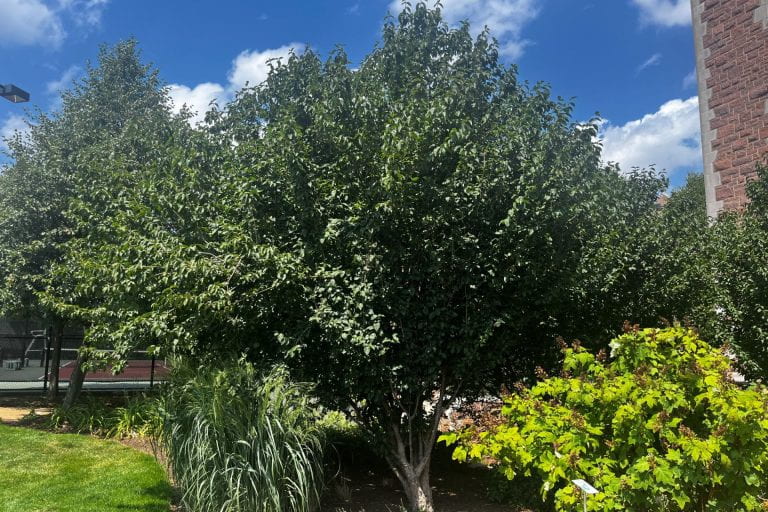
Cornelian Cherry Dogwood
Arbor Walk #122, TreeKeeper ID #2742
A beautiful non-native from Europe and Asia, this tree shows off its gorgeous star-shaped, yellow flowers in early spring before its leaves emerge.
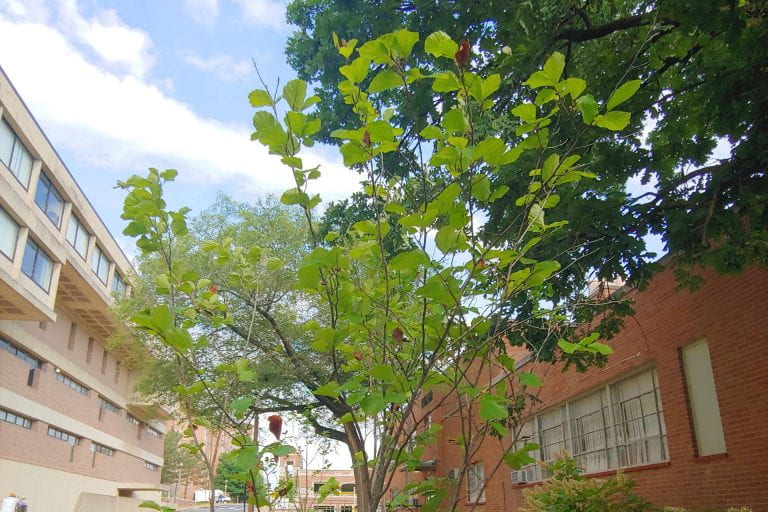
Cucumber Tree Magnolia
Arbor Walk #107, Treekeeper ID #5717
This tree is in the Magnoliaceae family and is native to Missouri. The cucumber tree is named by its cucumber-like fruit. The fruit is 2″ to 3″ long, slightly curved, and cylindrical, and to add to the cucumber appearance, the immature fruit is also green.
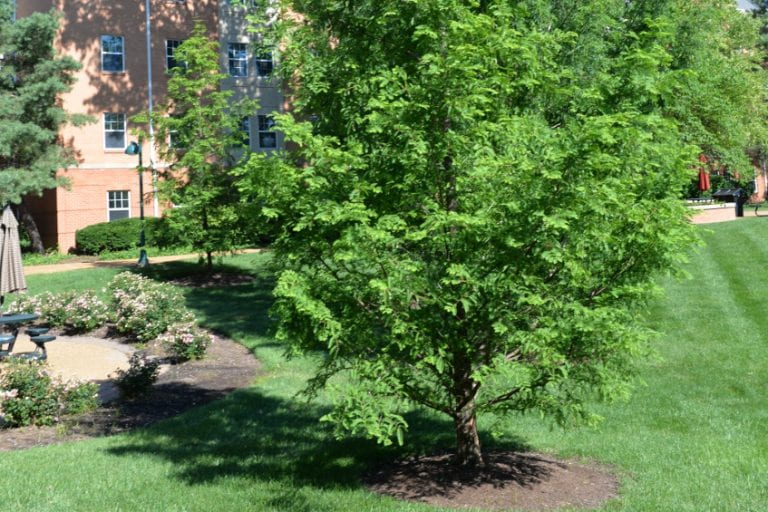
Dawn Redwood
Arbor Walk #73, Treekeeper ID #2196
The Dawn Redwood is considered a living fossil because it was only known due to the fossil remains from individuals that lived with the dinosaurs. It was not until the 1940’s that a small population was discovered in a remote valley of the Szechwan province of China.
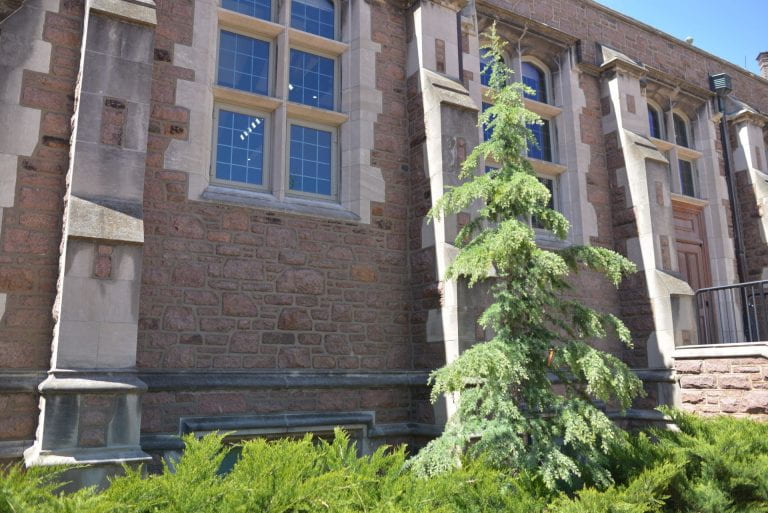
Deodar Cedar
Arbor Walk #34, Treekeeper ID #3817
This tree species is originally native to the Himalayas range, but due to its high tolerance to heat for a true cedar, it is able to grow in certain specific conditions in the United States such as the St. Louis area.
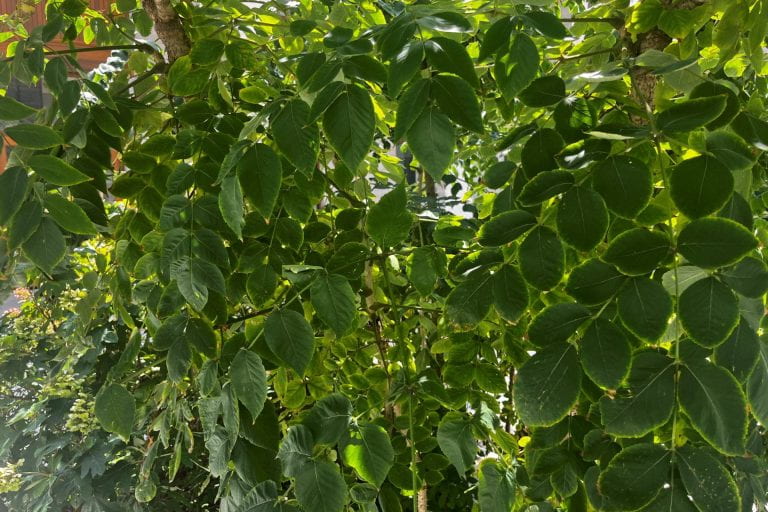
Devil’s Walking Stick
Arbor Walk #121, TreeKeeper ID #4652
This tree has many interesting features including late summer flowers, juicy black drupes, gigantic compound leaves, and sharp prickles covering many parts of the plant.
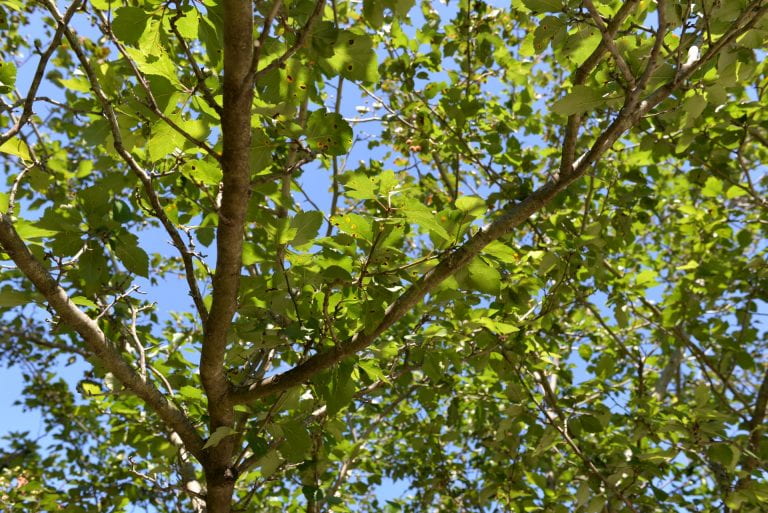
Downy Hawthorn
Arbor Walk #67, Treekeeper ID #1716
The Downy Hawthorn is a deciduous tree in the rose family, and is native to the Midwest. Despite the unpleasant scent and the presence of long thorns, the tree is much loved for the beauty of its flowers in the spring and fruits in the summer.
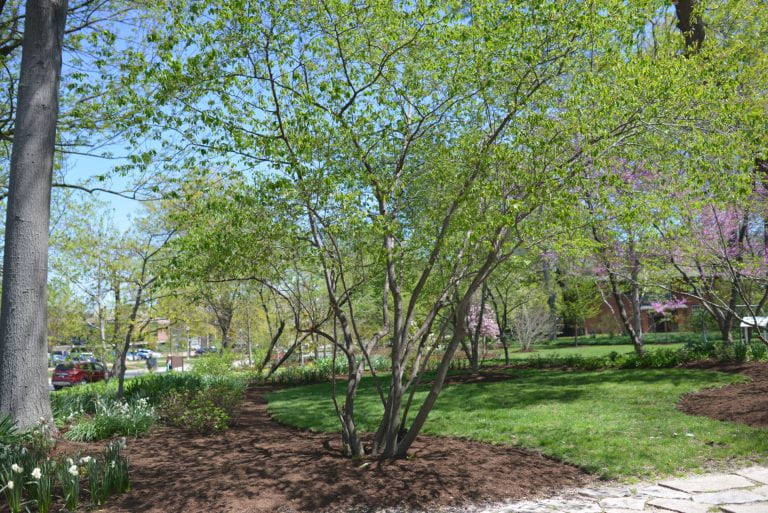
Downy Serviceberry
Arbor Walk #40, Treekeeper ID #4578
This Missouri native tree offers edible, berry-like fruit that changes color throughout the seasons. The competition for the fruit is stiff because they are a favorite of many bird species.

Drummond’s Red Maple
Arbor Walk #172, Treekeeper ID #3933
Comparatively to the other varieties of red maple, this variety inhabits areas with wetter sites and milder winters, such as swamps across the southeastern US.

Dwarf Chinkapin Oak
Arbor Walk #156, TreeKeeper ID #7173
The Dwarf Chinkapin Oak is a small but wonderful oak species that excels for landscaping and natural settings alike.
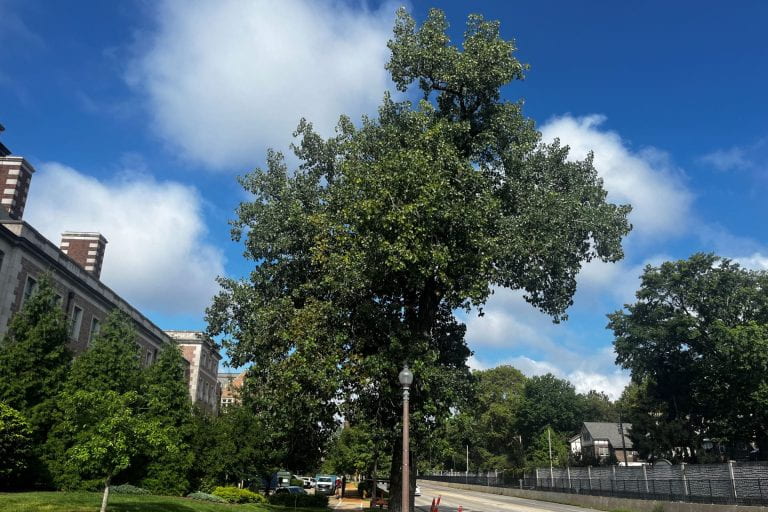
Eastern Cottonwood
Arbor Walk #167, TreeKeeper ID #1525
Native to much of the Eastern United States and Southern Canada, with a tall form reaching up to 100 feet in height and flexible fluttering leaves, the Eastern Cottonwood is a staple of lowlands across North America.
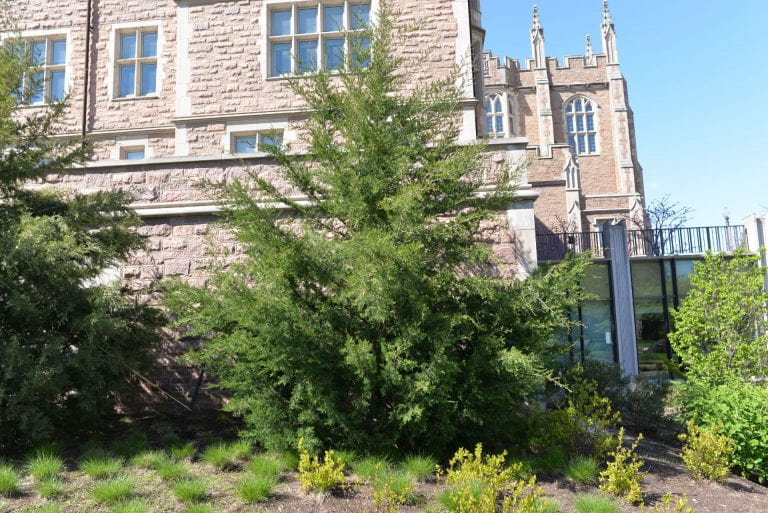
Eastern Red Cedar
Arbor Walk #51, Treekeeper ID #1648
This tree is native to Eastern North America; In Missouri, it grows in a variety of habitats across the state and is tolerant of a wide range of soil conditions.
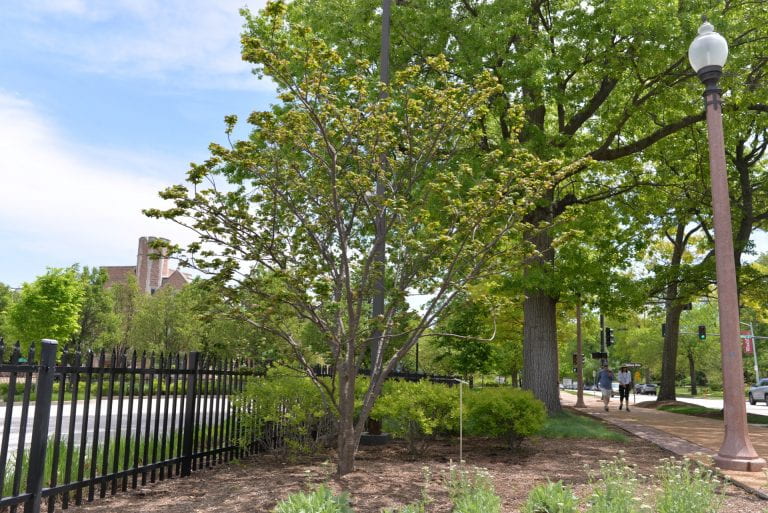
Eastern Redbud
Arbor Walk #38, TreeKeeper ID #3141
This deciduous understory tree is the state tree of Oklahoma and is native to Missouri and much of the Eastern and Central US. It grows in medium moisture, medium fertility soils.
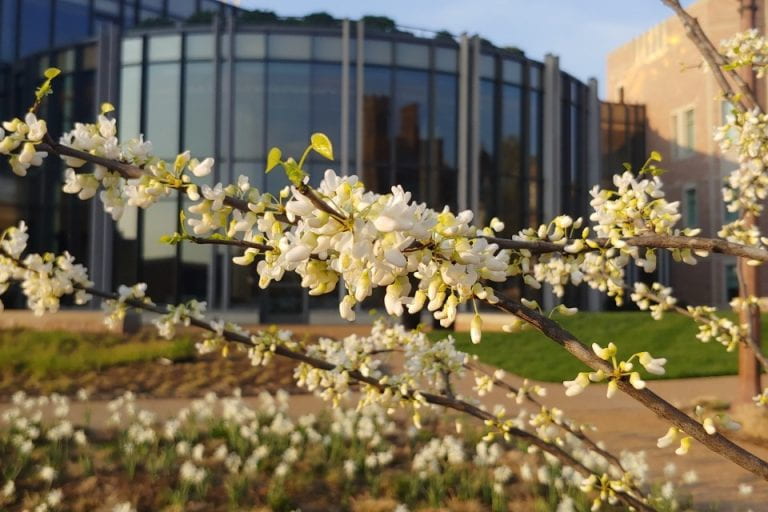
Eastern Redbud, White
Arbor Walk #86, Treekeeper ID #5725
White Bud is a native cultivar to the Missouri Area with heart-shaped leaves. Its parentage comes from the native Red Bud seen throughout Missouri.
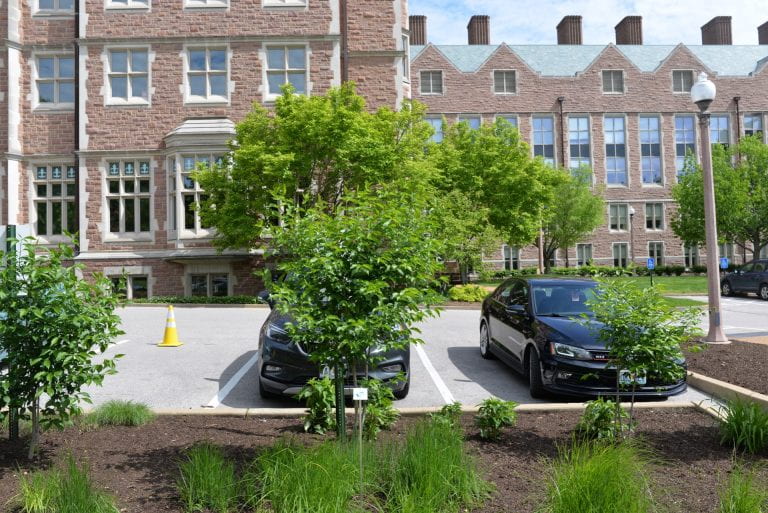
Eastern Wahoo
Arbor Walk #47, Treekeeper ID #6770
This small tree is a Missouri and Chicago-region native offering attractive bright red fruit and beautiful color in the fall.
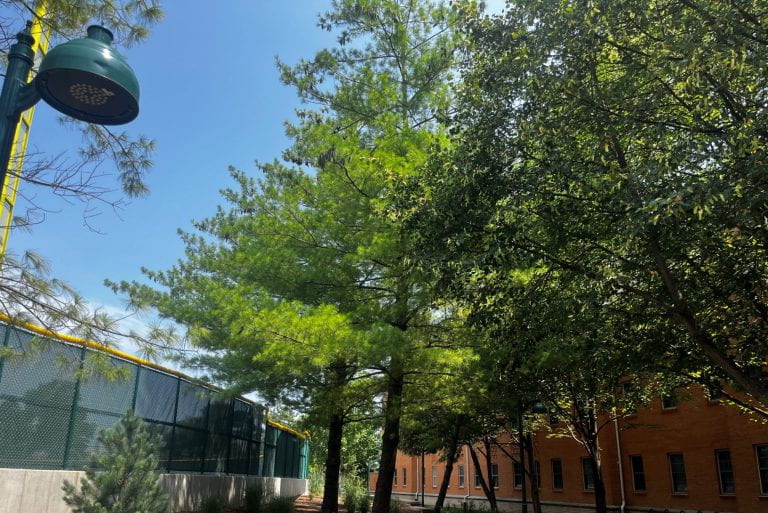
Eastern White Pine
Arbor Walk #134, TreeKeeper ID #3517
The Eastern White Pine (Pinus strobus) is considered to be the tallest tree east of the Rocky Mountains, and one of the most historically important. This tree, which ranges from 80′ up to 180+’ at its record tallest, was the premier tree for timber in North America in the 18th and 19th century. Due to its massive demand in furniture, construction, and farming, stands of this pine were dramatically wiped out by 1900.
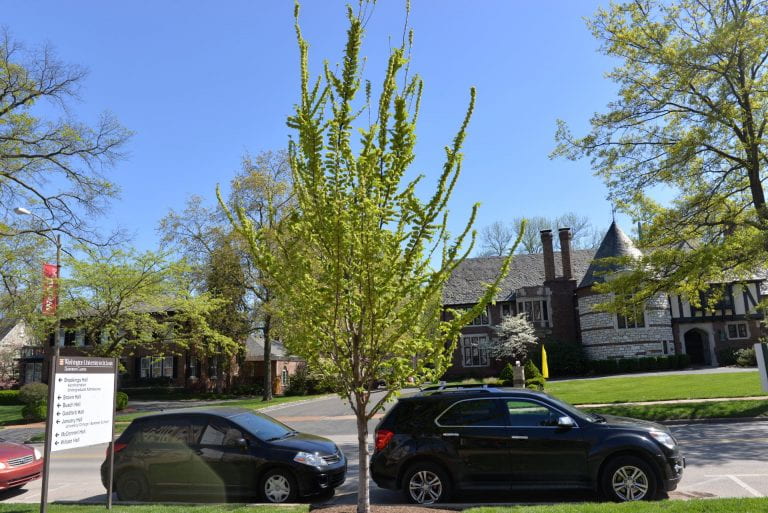
Emerald Sunshine Elm
Arbor Walk #52, Treekeeper ID #1676
This Asian hybrid Elm is a relatively small cultivar growing 35 feet high and 25 feet wide. It has glossy green leaves which turn yellow in the fall.
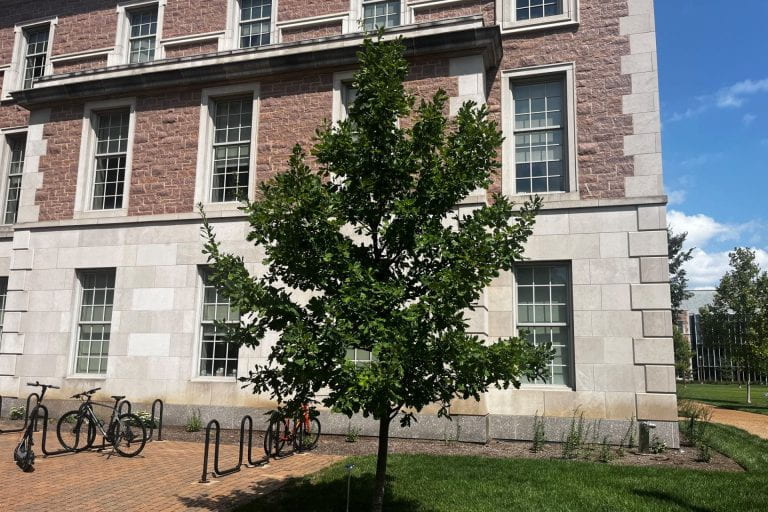
English Oak
Arbor Walk #99, Treekeeper ID #6570
English Oak is native and found in mixed woodland areas and planted widely in North America since the 1600s. It has long been a timber source in England.
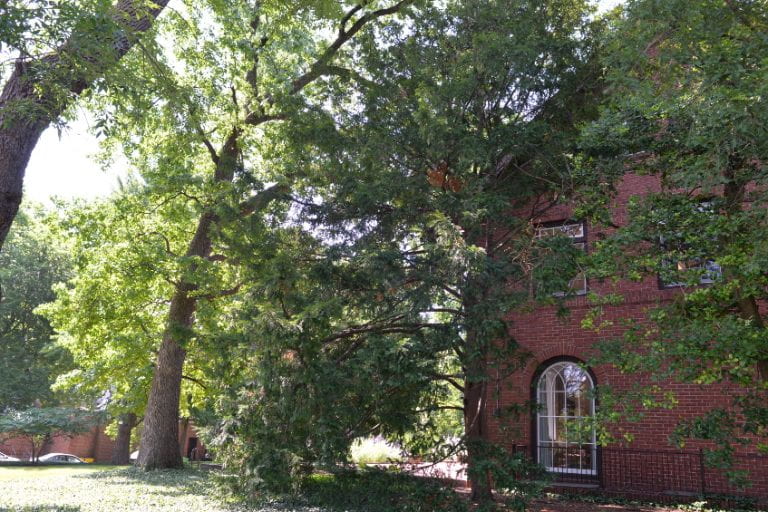
English Yew
Arbor Walk #65, Treekeeper ID #5329
Though associated with England, this tree is actually native to all of Europe, as well as southwestern Asia and Northern Africa. Red-brown scaly bark and evergreen dark green foliage ensures this tree is an attractive addition to landscapes year-round.
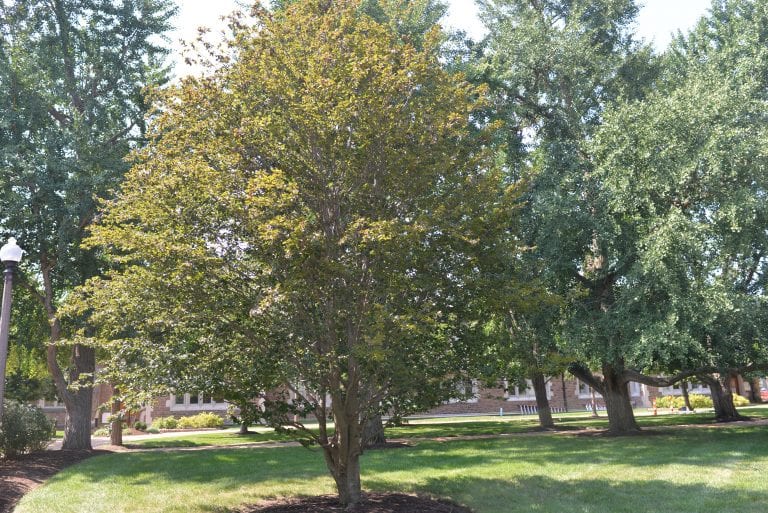
European Beech
Arbor Walk #14, Treekeeper ID #1691
This beautiful non-native tree is adaptable to the Midwest. It has golden bronze leaves in the fall and its bark has a gray, elephant-hide appearance.
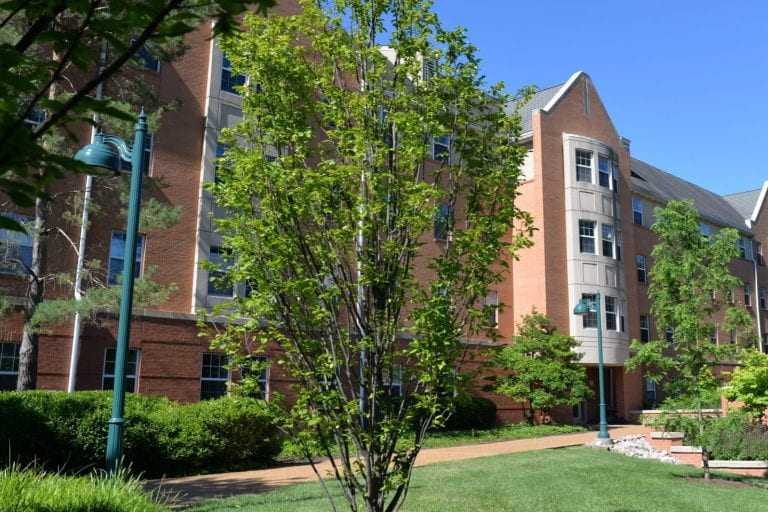
European Hornbeam
Arbor Walk #74, Treekeeper ID #2259
This adaptive species is often grown as a shield or hedge plant in urban settings, as it grows a thick canopy that extends most of the way to the ground.
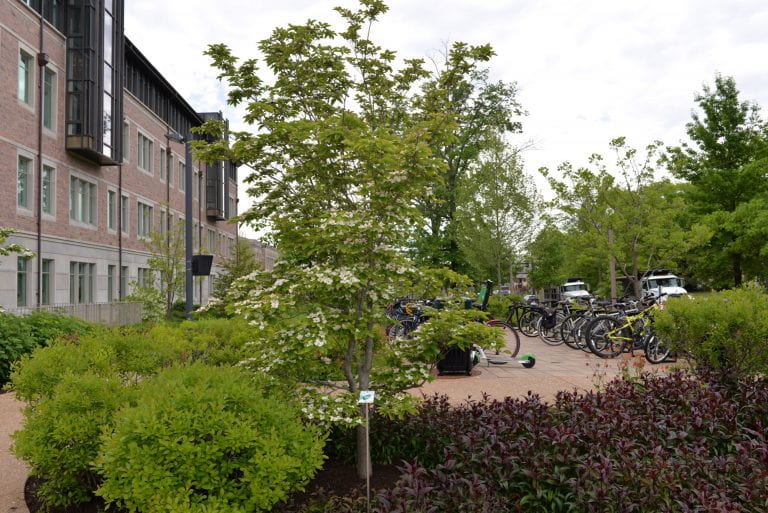
Flowering Dogwood
Arbor Walk #53, Treekeeper ID #1410
Often claimed as the most beautiful of North America’s native flowering trees, the Flowering Dogwood is the state tree of both Missouri and Virginia. Its early-spring blooms of showy white petals surrounding tiny clusters of yellow dogwood flowers are among the tree’s most dramatic characteristics.
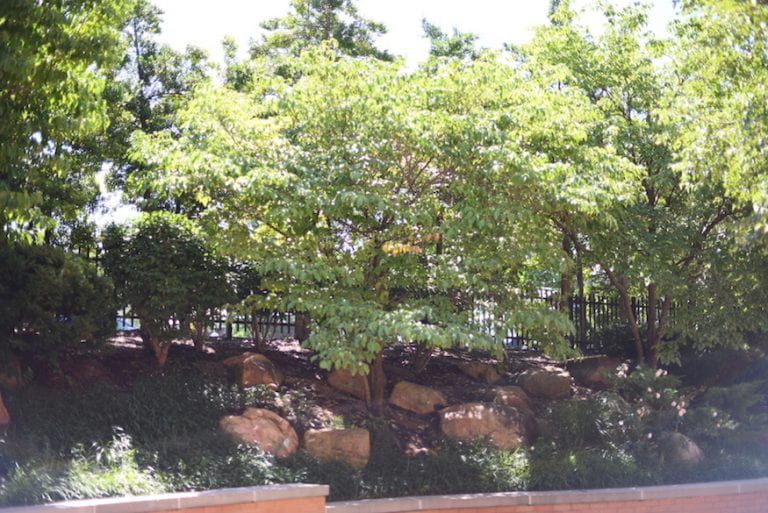
Flowering Dogwood
Arbor Walk #81, Treekeeper ID #3692
This is a small, beautiful, adaptive, flowering tree, blooming in early spring. It has white flowers and oval dark green leaves which turn into shades of red in the fall and it grows bitter, inedible bright red fruits.
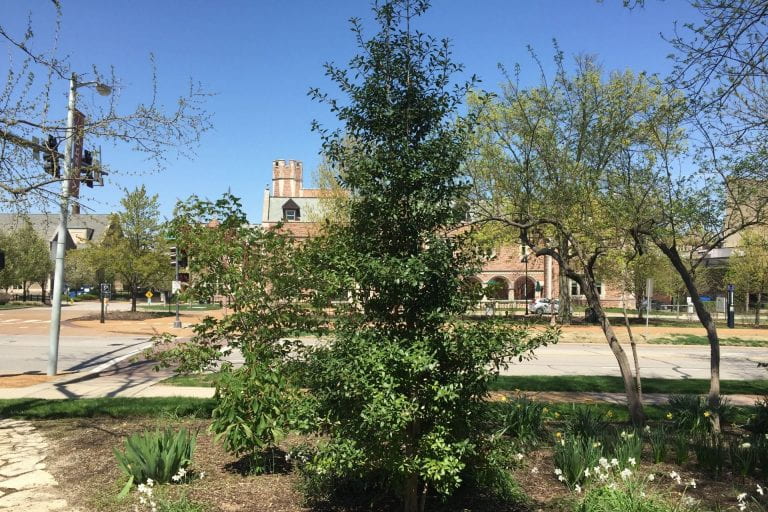
Foster Holly
Arbor Walk #39, Treekeeper ID #4373
A naturally occurring hybrid species of American Holly and Dahoon Holly, it was found growing in the wild in Florida in 1924. This is a broadleaf evergreen tree of small to medium stature that prefers well-drained, slightly acidic soil and dislikes extreme hot and cold temperatures.
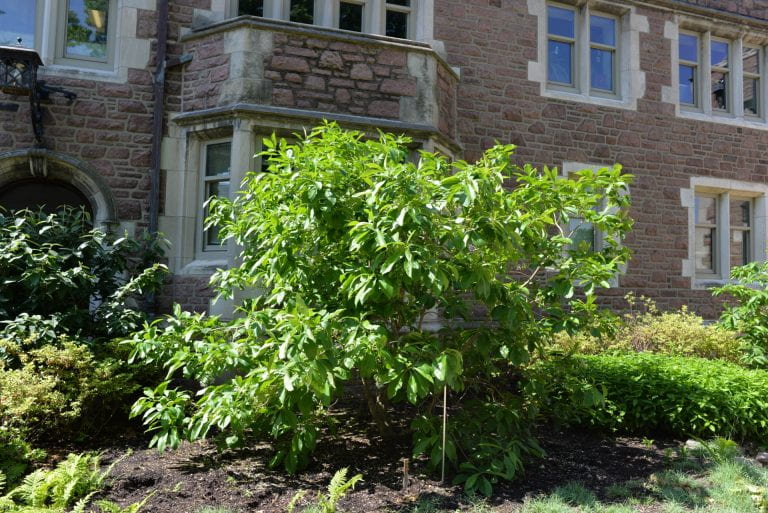
Fringe Tree
Arbor Walk #33, Treekeeper ID #5592
This tree is a Missouri native which grows easily in fertile, moist soil. In the wild, it typically grows at forest transition boundaries, along stream banks, or in the margins of limestone glades.
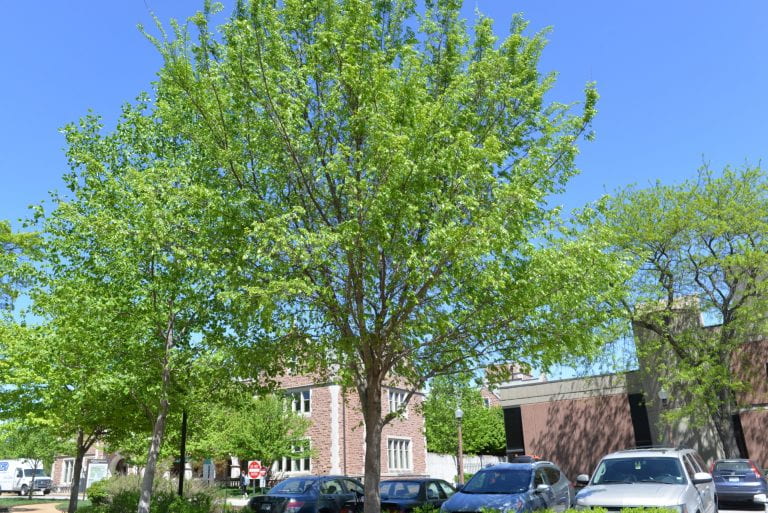
Frontier (Hybrid) Elm
Arbor Walk #44, Treekeeper ID #2942
This medium-sized tree is hardy and tolerant to drought, heat, and poor soil which make it well suited as a replacement for the many elms used residential landscapes and city streets.
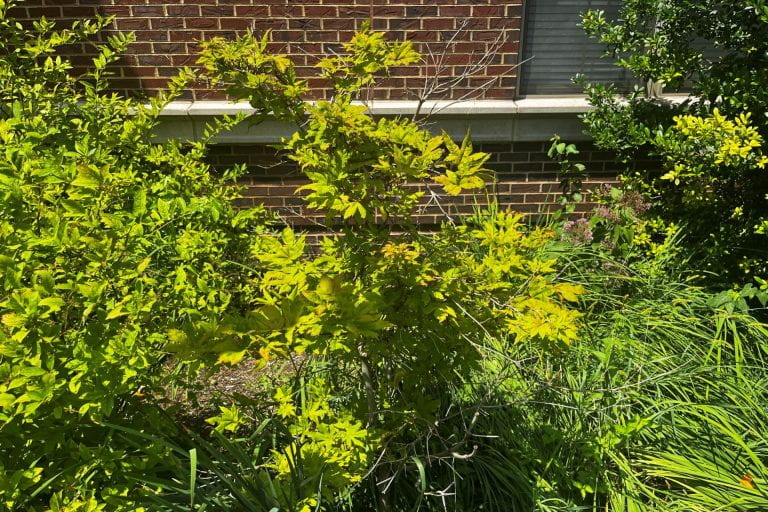
Full Moon Maple
Arbor Walk #135, TreeKeeper ID #6223
The Full Moon Maple is a small, dense tree with unique large, showy leaves that is native to Japan. These leaves create beautiful fall foliage and are mainly sought after for landscaping.

Giant Dogwood
Arbor Walk #165, Treekeeper ID #7247
Although the “Giant” moniker may seem to be overstating the tree’s height comparative to other trees in the region and on campus, this tree can be 20-30 feet taller than the native Flowering Dogwood, with larger leaves as well.
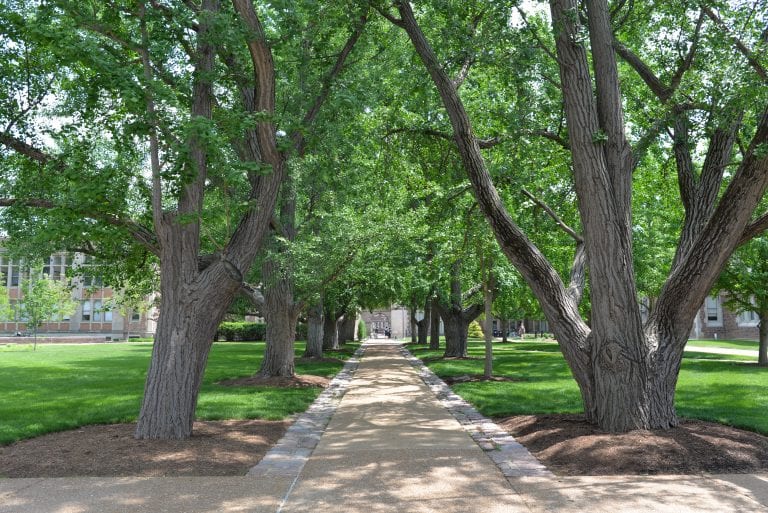
Ginkgo
Arbor Walk #12, Treekeeper ID #1649
This tree’s unique fan shaped leaves turn brilliant golden yellow in fall. This adjacent group of Ginkgos forms a historic allée that was part of the original 1927 Cope and Stewardson Plan for the university campus.
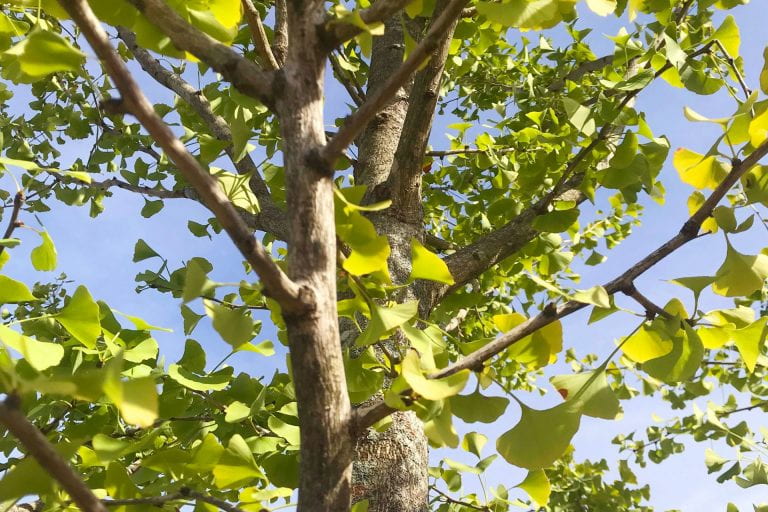
Ginkgo
Arbor Walk #96, Treekeeper ID #5779
The ‘Autumn Gold’ evolved over 200 million years ago and can withstand extremely harsh conditions. The tree produces a beautiful gold leaf color in Autumn, hence the name.
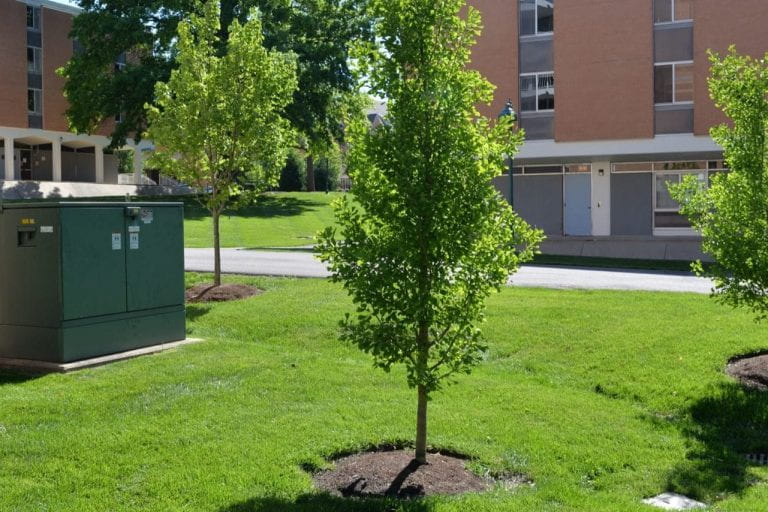
Ginkgo ‘Saratoga’
Arbor Walk #76, Treekeeper ID #5991
This unique pest-resistant species originated in China and is the last species in its order Ginkgophyta, which was first found in fossils that dated back to the Permian period, 270 million years ago.
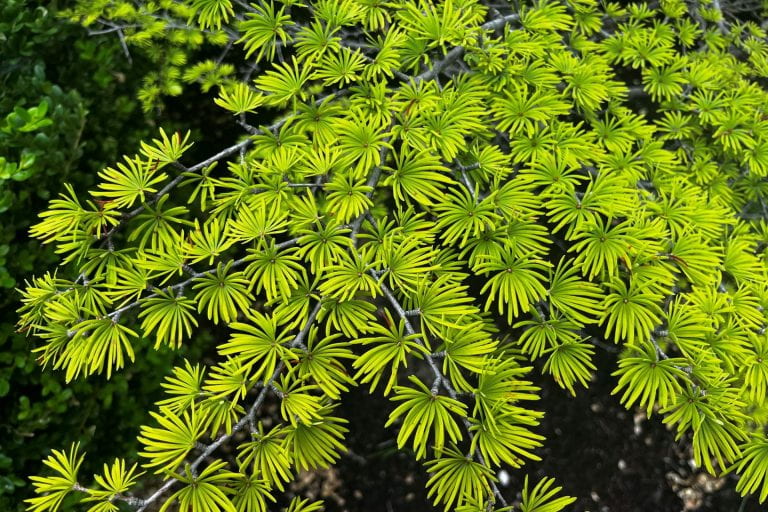
Golden Larch
Arbor Walk #116, TreeKeeper ID #6505
One of the more unique members of the Pine family (Pinaceae), this tree has a circular spray of soft, thick needles and mature cones that resemble upside down succulents or artichokes. Originating from eastern China, this species thrives in the warm, wet environments of the American Midwest and Southeast.
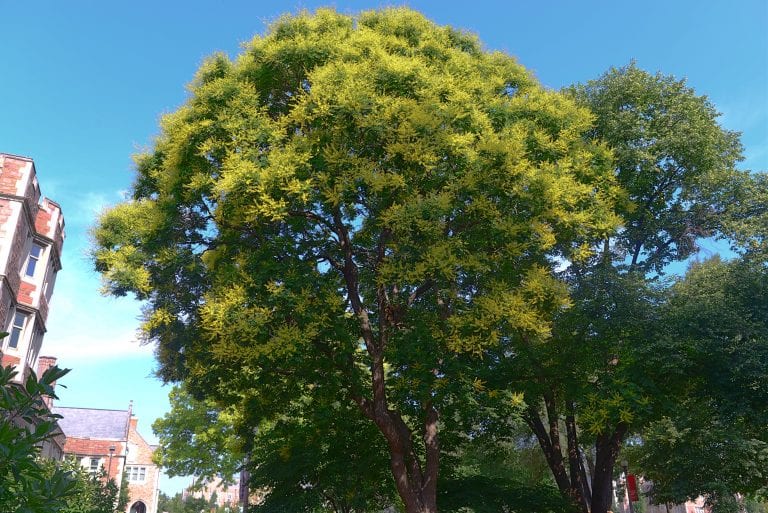
Golden Raintree
Arbor Walk #24, Treekeeper ID #3978
This tree’s unique foliage, summer blooming yellow flowers, and lantern-like fruit make it one of the most interesting trees in the campus forest.
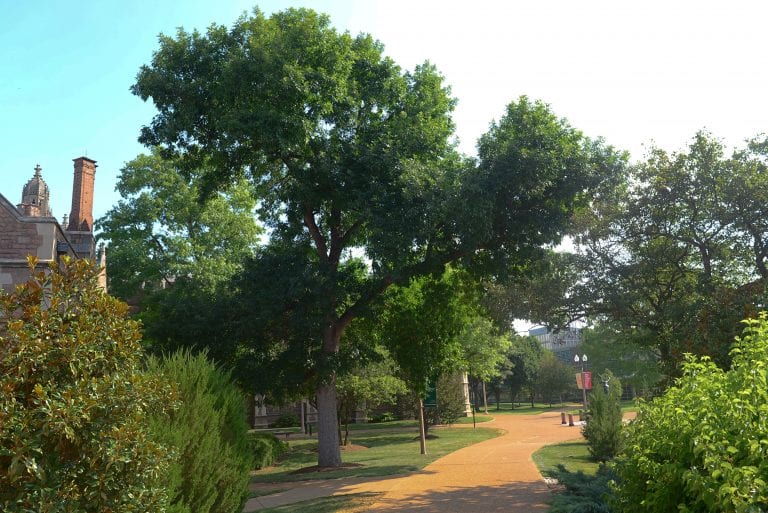
Green Ash
Arbor Walk #23, Treekeeper ID #2384
This native tree species is threatened by the Emerald Ash Borer. Since its discovery in 2002, the Borer, a native of Asia, has killed hundreds of millions of ash trees in North America.
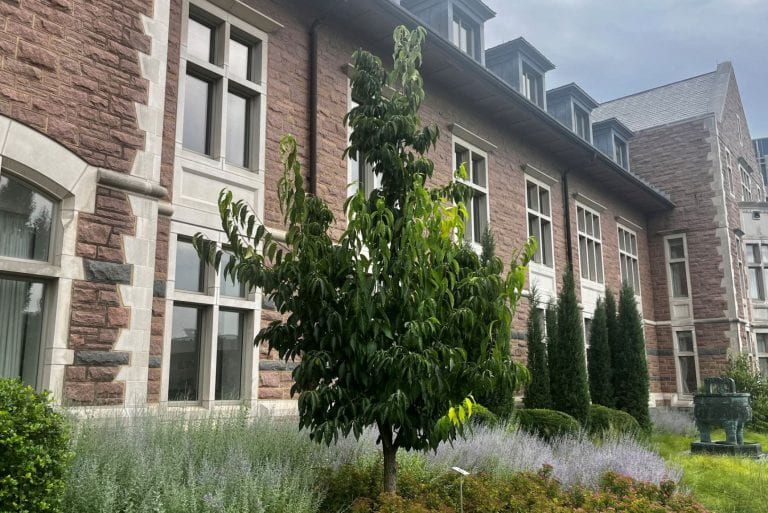
Hardy Rubbertree
Arbor Walk #120, TreeKeeper ID #6643
This tree gets its name from the gummy sap contained in the tree’s leaves, branches, and bark, which does not pour out like a milkweed but rather pulls apart with sticky strings like half-dried glue. Native to China, this tree has been traditionally used to treat high blood pressure, liver, and kidney issues.
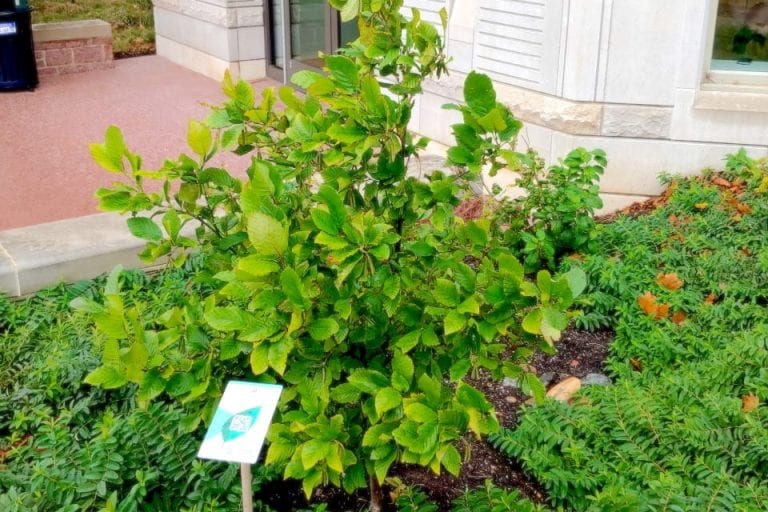
Hazel Alder
Arbor Walk #97, Treekeeper ID #6102
Hazel Alder is a multi-stemmed small tree and can grow to 20′ high and up to 15′ wide forming thickets by suckering. It is native from Nova Scotia to Illinois and Missouri south to eastern Texas and northern Florida. It is an ideal selection for naturalizing or rain gardens.
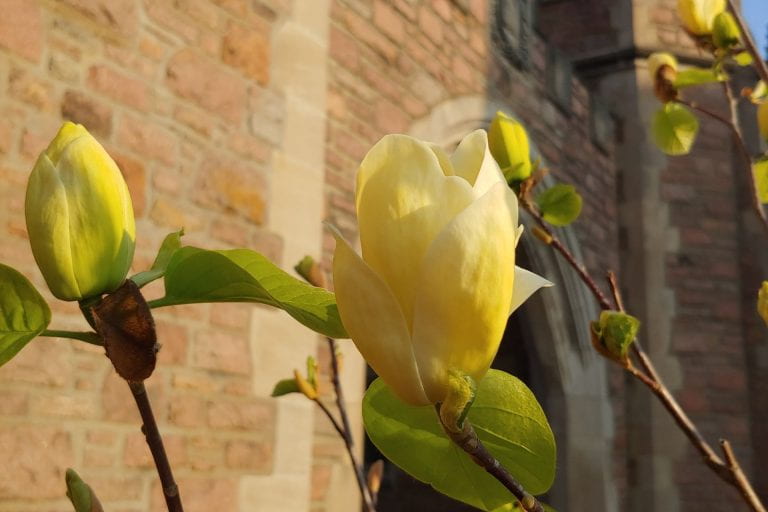
Hybrid ‘Lois’ Magnolia
Arbor Walk #90, Treekeeper ID #5902
Magnolia ‘Lois’ is adaptive to the St. Louis region and was introduced in 1998 by the Brooklyn Botanical. It flowers in the Spring with a true pale yellow color and it grows to 30′ tall and 20′ wide.
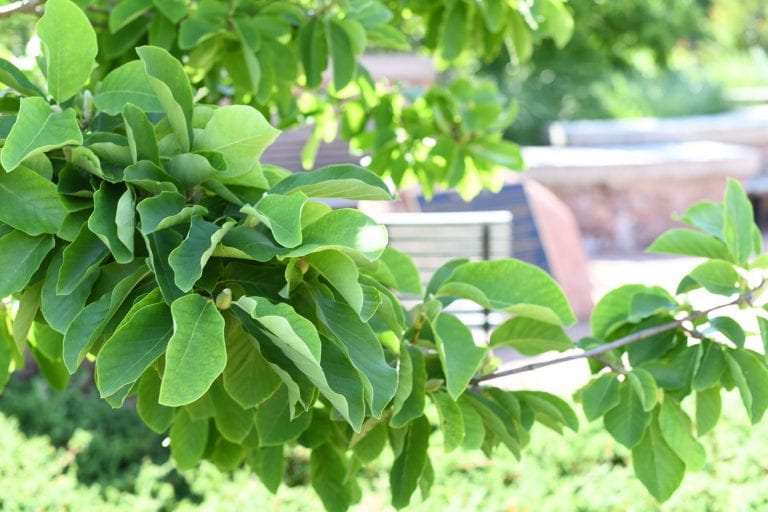
Hybrid Magnolia
Arbor Walk #82, Treekeeper ID #3854
This is a deciduous hybrid magnolia resulting from a cross between M. acuminata and M. denudata. It is notable for its yellow flowers, late vegetative growth, compact pyramidal form, and ability to withstand both heat and cold.

Hybrid Oak
Arbor Walk #125, TreeKeeper ID #5965
The Heritage Oak is a hybrid between the English Oak (Quercus robur) and the Bur Oak (Quercus macrocarpa), two similar white oaks from different continents. These closely related species produce a sturdy, fast-growing oak with the large acorns of the Bur Oak and fall colors of the English Oak.

Hybrid Willow
Arbor Walk #117, TreeKeeper ID #6815
This willow is a hybrid between the Bay Willow (Salix pentandra) and the Eastern Crack-willow (Salix euxina). It was developed at North Dakota State University and is known for its rounded shape, vigorous foliage, and its namesake reflective leaves that lend the ‘Silver Lake’ epithet.

Jack’s Hybrid Oak
Arbor Walk #146, Treekeeper ID #6549
This oak is a naturally occurring hybrid of White Oak (Quercus alba) and Swamp White Oak (Q. bicolor).

Japanese Cornel Dogwood
Arbor Walk #113, TreeKeeper ID #3538
The Japanese Cornel Dogwood boasts elegantly characteristic dogwood leaves, edible fruits (yet quite astringent when raw), and traditional medicinal use in East Asia for liver and kidney illnesses.
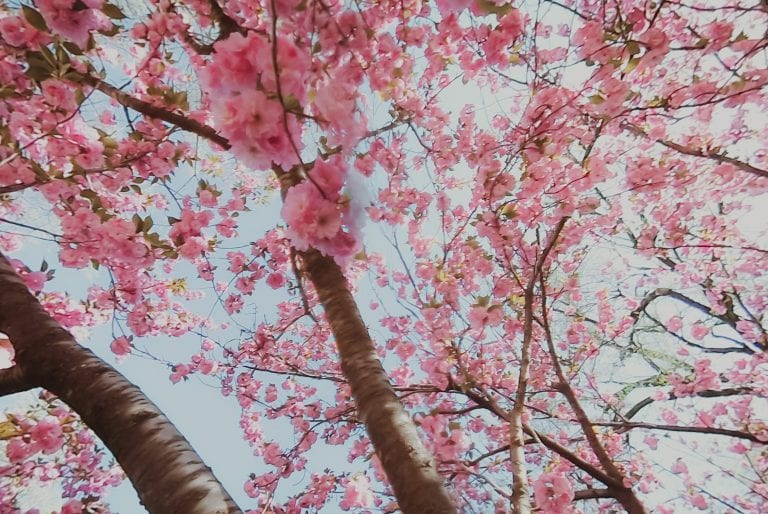
Japanese Flowering Cherry
Arbor Walk #25, Treekeeper ID #4120
The Kwanzan variety is probably the hardiest of the double flowering cherry trees. Its new leaves are bronze colored and its fall color is a bronzy-orange. It blooms pink in mid spring and is the last of the cherry trees to bloom.
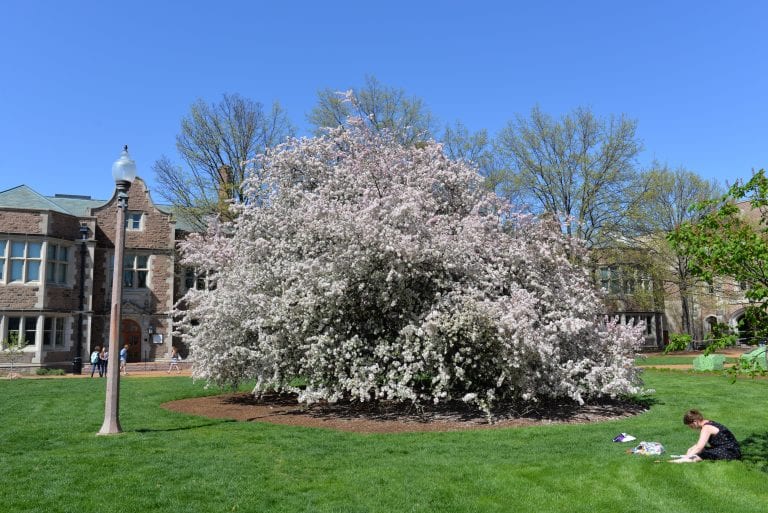
Japanese Flowering Crabapple
Arbor Walk #11, Treekeeper ID #1607
This small flowering tree belongs to a family of trees that are popular for their profuse spring flowers. This tree also produces its namesake crabapples, which are edible except for the seed, yet very small. Arbor Walk #11 has a dome-like shape and students often study underneath the tree’s canopy in hotter months.
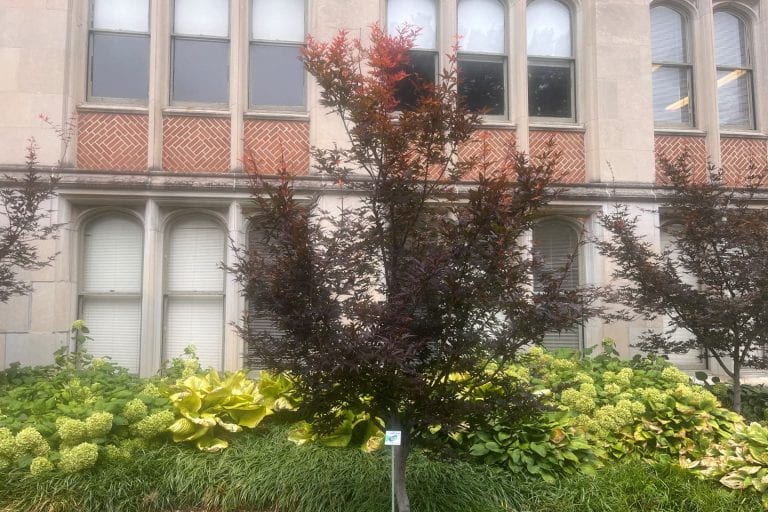
Japanese Maple
Arbor Walk #136, TreeKeeper ID #6159
The Japanese Maple has been cultivated in and around its native range for hundreds of years, and since the 1800s, has been symbolic of Japanese Gardens to Western observers.
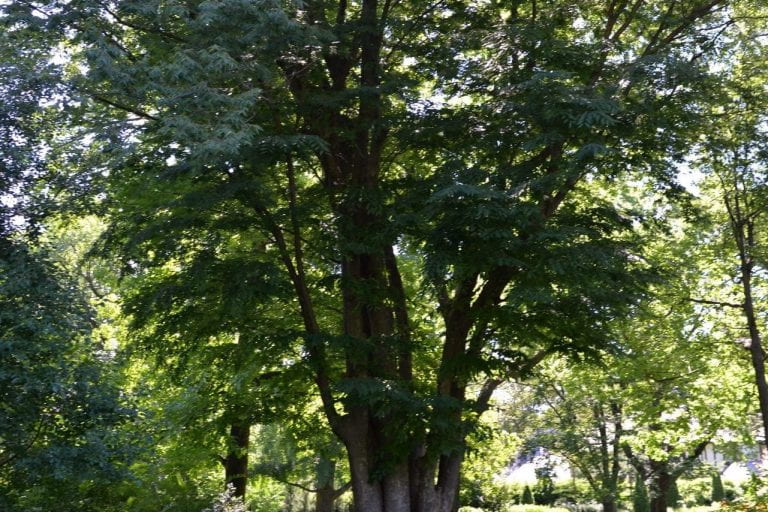
Japanese Zelkova
Arbor walk #59, Treekeeper ID #5340
A member of the Elm family which has been promoted as a replacement to American Elms because of its high degree of resistance to Dutch Elm Disease.
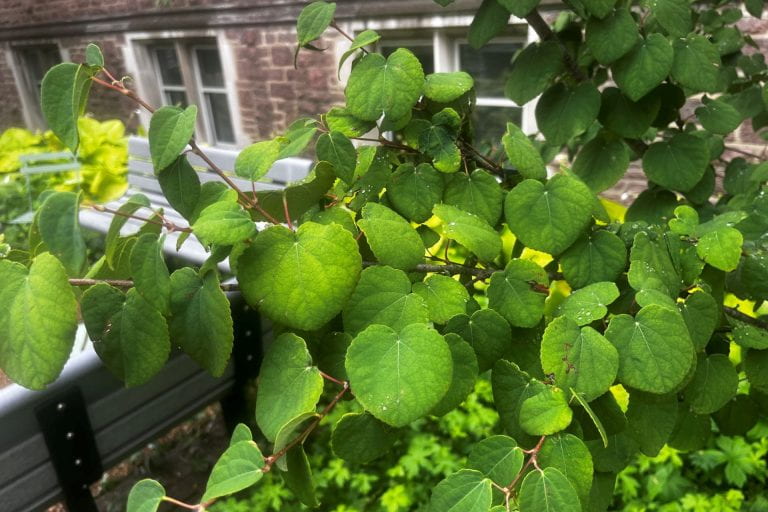
Katsuratree
Arbor Walk #106, Treekeeper ID #5947
The Katsuratree’s native range in Japan and China. The ‘Rotfuchs’ cultivar is most commonly cultivated in the United States. In cultivation, it can grow to 60′ tall and is noted for its beautiful shape and attractive foliage.
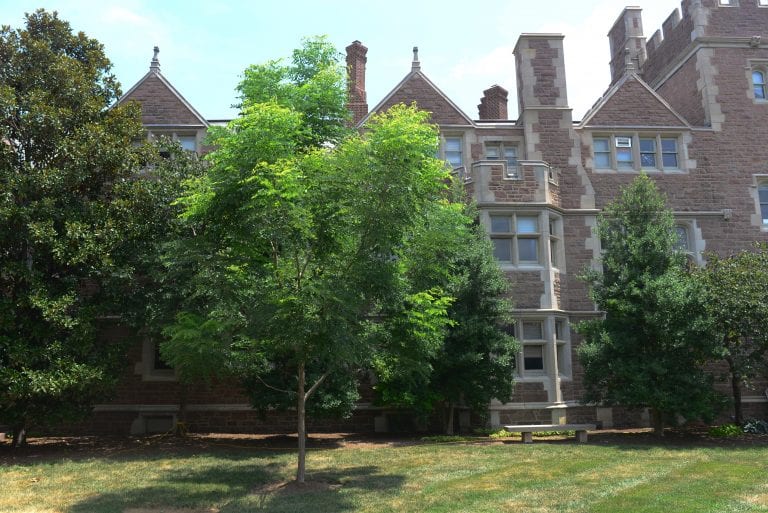
Kentucky Coffeetree
Arbor walk #7, Treekeeper ID #2253
This tree is a “seedless” variety of the native species. It is native to Missouri and the Midwest. Early settlers of Kentucky used the tree’s seeds as a coffee substitute, hence its common name.
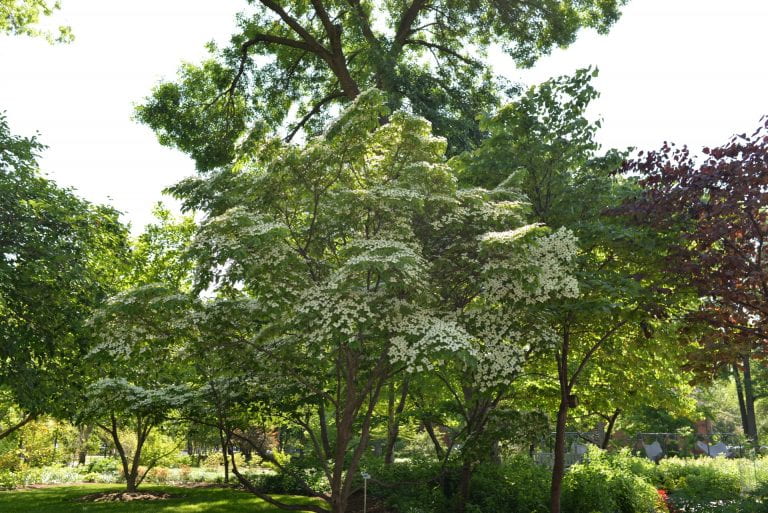
Kousa Dogwood
Arbor walk #41, Treekeeper ID #4568
This tree, native to Asia, is known for its four-petaled white flowers in June and its reddish-purple color in Fall.
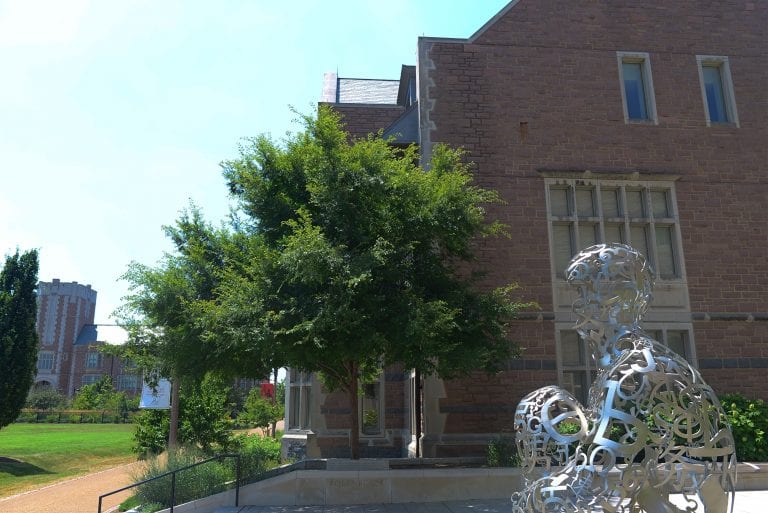
Lacebark Elm
Arbor walk #5, Treekeeper ID #3495
The Lacebark Elm is a large elm native to China that is known for its intricate bark and durable wood. It has strong resistance to the deadly Dutch Elm Disease, making it an ideal planting or hybridization target.
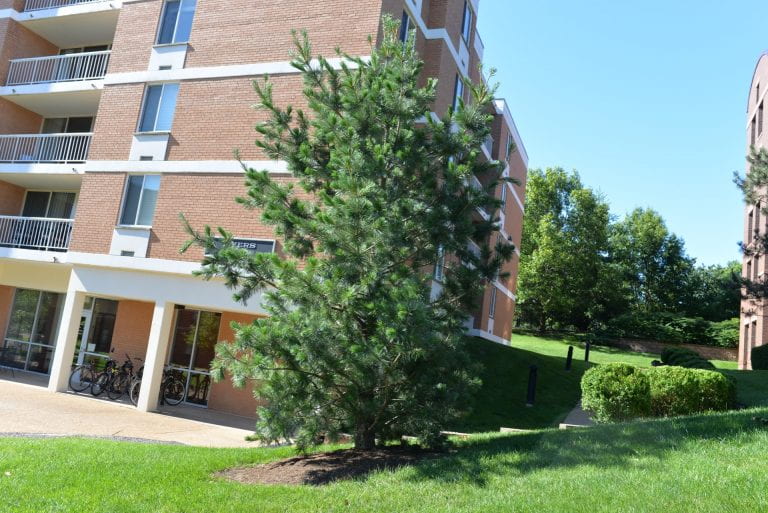
Limber Pine
Arbor walk #72, Treekeeper ID #3697
This under-used pine, native to the western United States, is more tolerant of alkaline soils than the Eastern white pine. The dark blue green needles help this tree stand out in the landscape.
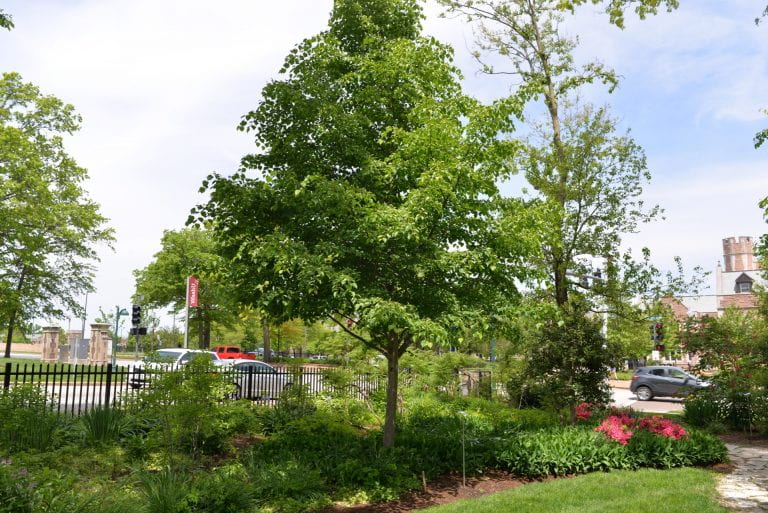
Littleleaf Linden
Arbor walk #42, Treekeeper ID #4386
The Little-Leaf Linden is uniquely adept at withstanding polluted environments, and is therefore a great shade tree for urban settings. It is a native to Europe and exists in the wild only in protected pockets of land, where it provides ecological benefits for moths and pollinators.

Loblolly Pine
Arbor Walk #126, TreeKeeper ID #6651
The Loblolly Pine is an iconic tree in the Southeastern United States, dominating the southern pine forests and being grown for lumber in plantations in the region. It is tall, skinny in shape, and a vigorous grower.
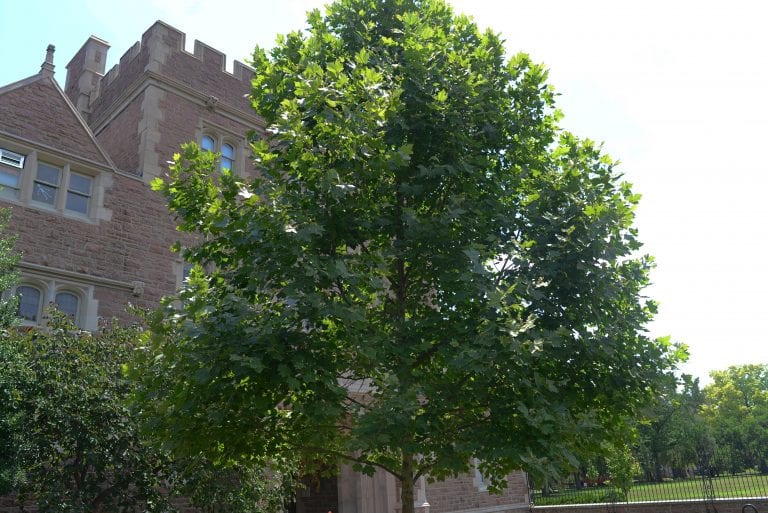
London Planetree
Arbor walk #6, Treekeeper ID #2200
The London Planetree is a hybrid of the Oriental Plane (Platanus orientalis) and American Sycamore (Platanus occidentalis), combining improved disease resistance with cold tolerance. The London Planetree is also extremely tolerant of pollution, and is even found to be an effective removal agent of air pollution particles.
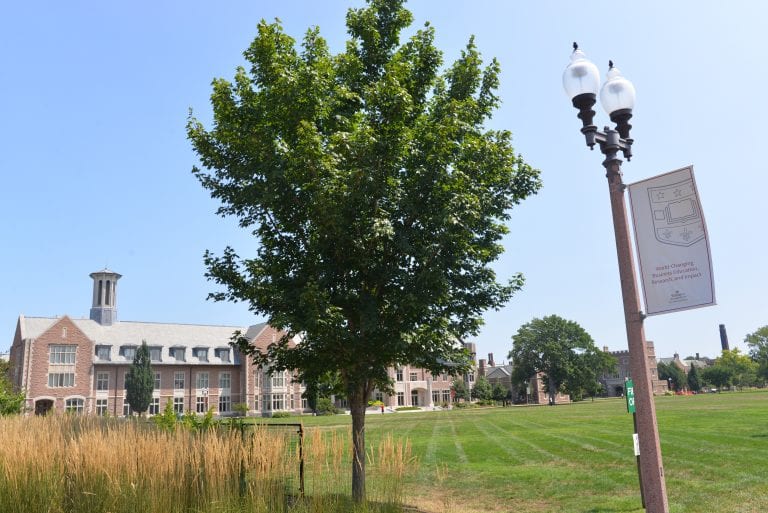
Miyabe Maple
Arbor walk #2, TreeKeeper ID #3153
This tree is native to Japan, although it has become endangered within its own native range. This cultivar was introduced at the Morton Arboretum in Illinois.

Nannyberry Viburnum
Arbor Walk #133, TreeKeeper ID #1694
The Nannyberry Viburnum features edible berries that persist in winter and abundant white flowers. It is a tall shrub or small tree, reaching about 15′ in height as a multi-stemmed shrub, or pruned into one trunk up to 30′.